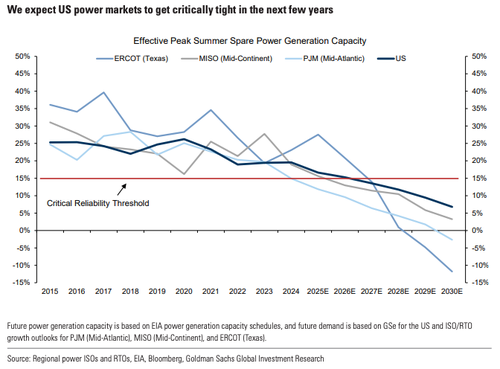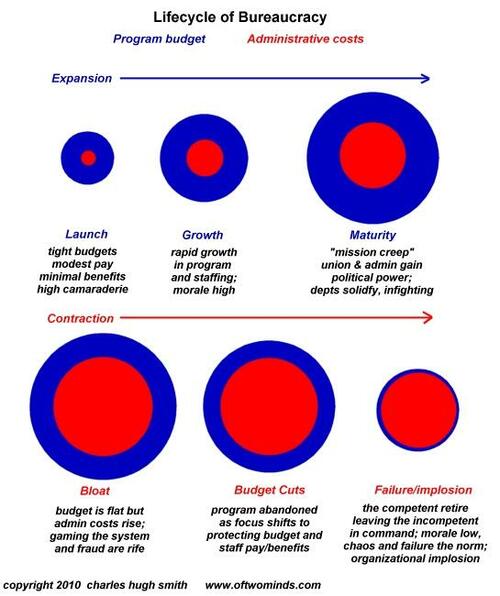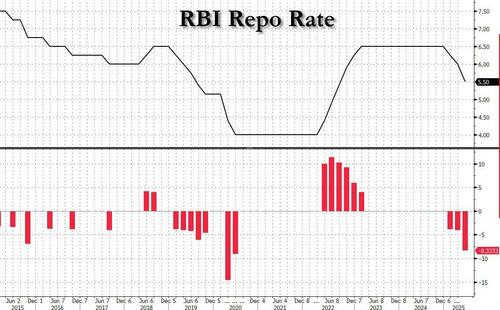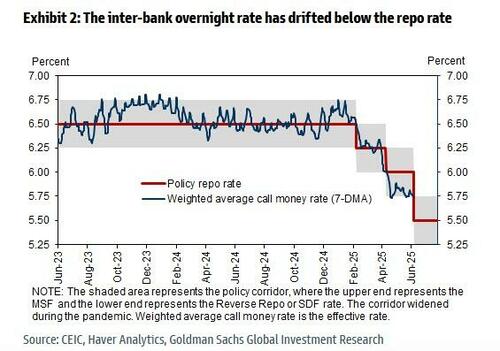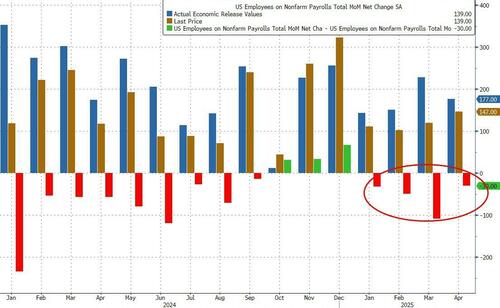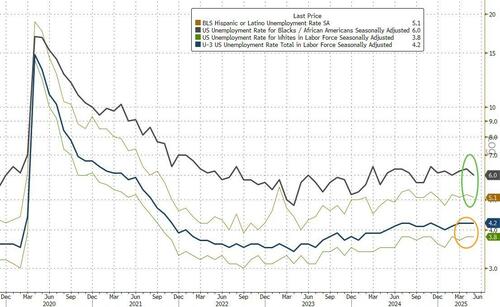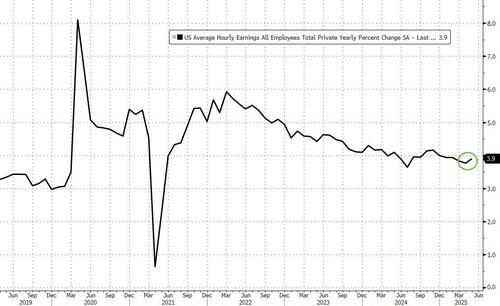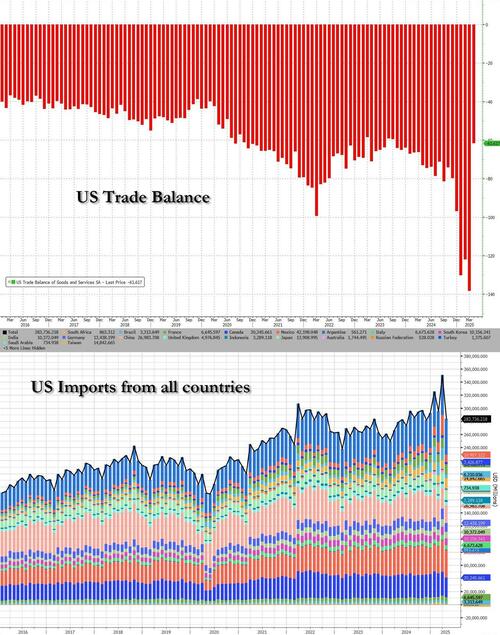“If you believe what you like in the Gospels, and reject what you don’t like, it is not the Gospel you believe, but yourself.”
Distinction Matter - Subscribed Feeds
-
Site: PeakProsperityMusk-Trump feud highlights that DC will never change on its own, even with people showing up with the best of intentions. Instead, it will continue pushing the country deeper into debt until something breaks.
-
Site: PeakProsperityThe behavior of DC politicians is not hard to decipher. With precious few exceptions, they lack the wisdom and/or the knowledge to diagnose the predicaments, and even fewer have the willpower to be honest with the American people. So we're on a collision course with 'going broke.' In my view, this is now unavoidable.
-
Site: Zero HedgeUS Investigates Army Vehicle Displaying Word 'Kafir' In Northeast SyriaTyler Durden Fri, 06/06/2025 - 18:25
The US-led coalition in Syria has launched a formal investigation after "unapproved symbols or language" were observed on a US military vehicle in northeast Syria, the coalition said in a statement to Middle East Eye on Friday.
On Thursday, MEE reported that a US military vehicle patrolling near the city of Hasakah last weekend displayed the word "kafir" - infidel in Arabic - on its front next to a Christian cross.
 A US armored vehicle bearing the word 'kafir' patrols near the city of Hasakah in northeast Syria on 31 May 2025, via MEE
A US armored vehicle bearing the word 'kafir' patrols near the city of Hasakah in northeast Syria on 31 May 2025, via MEE
The term "kafir" gained global notoriety during the Syrian war, frequently used by the Islamic State (IS) and other extremist groups to justify violence against those deemed non-believers - including Muslims who did not share their ideology.
Local residents described the graffiti as "offensive" and a "provocation", particularly as IS no longer has a presence in the region.
"Markings of this nature violate U.S. Department of Defense policy," the Combined Joint Task Force-Operation Inherent Resolve (CJTF-OIR) said in a written statement. "CJTF-OIR has initiated a formal inquiry and will implement appropriate disciplinary measures under the Uniform Code of Military Justice.
"This incident does not reflect the professionalism of our personnel or our respect for the Syrian people. While fact-finding is underway, our mission remains unchanged, enabling the enduring defeat of ISIS in Syria and Iraq."
The CJTF-OIR began operations in October 2014 [ostensibly] as the US-led coalition to defeat IS in Syria and Iraq.
Earlier this week, the US special envoy to Syria announced that the United States would reduce its military presence in the country, scaling down from eight bases to three in Hasakah.
Speaking to MEE, Jihan, a 34-year-old Kurdish woman, said it was hard to discern the intended message behind the markings. "We have nothing to do with IS, we don’t consider Americans to be kuffar [plural of kafir], and even less so the Christians who have always lived in Syria," she said.
Syria was one of the first places in the world to have a Christian community – the community is mentioned in the Book of Acts and St Paul’s famous conversion on the road to Damascus...
— Archaeo - Histories (@archeohistories) July 28, 2024
Christians are not foreign to Syrian land; they have not been imported; they are, in fact,… pic.twitter.com/zty0Plep2fThere are currently an estimated 2,000 American troops in Syria, with the number expected to be halved in the coming months.
-
Site: Edward FeserPhrenology was the pseudoscience that aimed to link psychological traits to the morphology of the skull. Physiognomy was the pseudoscience that aimed to link such traits to facial features. In his Phenomenology of Spirit, Hegel critiques these pseudosciences. Since they are now widely acknowledged to be pseudosciences, it might seem that Hegel’s critique can be of historical interest only. But as the late Alasdair MacIntyre pointed out in his essay “Hegel: On Faces and Skulls,” Hegel’s main points can be applied to a critique of today’s fashionable attempts to predict psychological traits and human actions from physiological and genetic traits. (The essay appears in the collection Philosophy Through Its Past, edited by Ted Honderich.)
That idea alone makes Hegel’s arguments worthy of our consideration. For it would certainly be of interest if it turned out that the fundamental problems with pseudosciences like phrenology and physiognomy had to do, not with their inadequacies vis-à-vis the empirical evidence, but with deeper philosophical assumptions they share with purportedly more empirically plausible and respectable versions of materialist reductionism. The arguments are not, however, presented with maximal crispness. But they are suggestive and worth trying to tease out. What follows is an attempt to do so (and its focus is on Hegel as MacIntyre reads him rather than on Hegel’s own texts).
The appeal to the past
MacIntyre notes several ways in which Hegel takes there to be a mismatch between brute anatomical and physiological facts on the one hand, and human thought and action on the other. But it seems to me that there are two main lines of argument identified by MacIntyre. The first, as I understand it, goes like this. Scientific explanations, including physiological explanations, appeal to general propositions, such as propositions of the form “For every x, if x is F then x is G.” For example, we might explain why a particular glass of water froze by saying “For every x, if x is water then x will freeze at 32 degrees Fahrenheit.” Our predicates F and G refer to universals, and we explain the particular phenomenon by simply noting that it is an instance of a completely general truth.
However, Hegel argues, human actions cannot be understood in this way. Suppose, for example (mine, not Hegel’s or MacIntyre’s), that you have a fight with your brother over some longstanding grudge between the two of you. Properly to explain this event requires reference to particular earlier events in your history, such as a promise to you that he once broke, or an occasion when you publicly insulted and embarrassed him. And those events will in turn be explicable in terms of yet other and earlier particular events. Understanding the character of these events will also involve attention to a variety of contextual details, such as who exactly was present on the occasion you publicly insulted him, and exactly what it was he had promised to do and why it was significant. Furthermore, it will involve attention to how all the relevant parties conceived of these various details.
These circumstances, thinks Hegel (as presented by MacIntyre) simply cannot be captured in general propositions of the kind to which scientific explanations appeal. In particular, there are no true generalizations to the effect of “For every x and every y, if x and y are brothers and x breaks a promise to y, then x and y will get in a fight several years later” (or whatever). What makes the sequence of events intelligible, in Hegel’s view, is not that it is a particular instance of a general pattern, where all events of the one kind will be followed by events of the other. Rather, that you acted in light of certain particular, contingent historical circumstances is an ineliminable aspect of the story, and cannot be captured in general or lawlike propositions. You are responding to those circumstances qua particular, not to just any old circumstances that happened to be of that general type. As MacIntyre writes, “to respond to a particular situation, event, or state of affairs is not to respond to any situation, event, or state of affairs with the same or similar properties in some respect; it is to respond to that situation conceived by both the agents who respond to it and those whose actions constitute it as particular” (p. 329).
What should we think of this argument? I’m not sure. Certainly it would need much tightening up before it could be judged compelling. However, it does seem to be at least in the general ballpark of arguments that I think are powerful. For example, it is reminiscent of Donald Davidson’s famous principle of the anomalism of the mental, according to which there can be no strict laws by which mental events might be predicted and explained. (Though Davidson’s argument too needs tightening up.)
The appeal to the future
What seems to me to be a second, distinct Hegelian argument discussed by MacIntyre (albeit not characterized by him as such) is expressed in this passage:
From the fact that an agent has a given trait, we cannot deduce what he will do in any given situation, and the trait cannot itself be specified in terms of some determinate set of actions that it will produce… [T]he crucial fact about self-consciousness… is, its self-negating quality: being aware of what I am is conceptually inseparable from confronting what I am not but could become. Hence, for a self-conscious agent to have a trait is for that agent to be confronted by an indefinitely large set of possibilities of developing, modifying, or abolishing that trait. Action springs not from fixed and determinate dispositions, but from the confrontation in consciousness of what I am by what I am not. (p. 331)
The idea here seems to be that to be conscious of oneself as an agent is, of its nature, precisely to be conscious of the possibility of an indefinite number of alternative choices. By contrast, to understand an anatomical or physiological feature is to know it as limited to a certain specific and relatively narrower range of effects in might have. Whereas, in Hegel’s first argument, the idea is that a reductionist physiological explanation cannot account for the significance of one’s past, in this argument the idea is that it cannot account for the openness of one’s future.
To make the point a little clearer, consider this passage from earlier in MacIntyre’s essay:
The relation of external appearance, including the facial appearance, to character is such that the discovery that any external appearance is taken to be a sign of a certain type of character is a discovery that the agent may then exploit to conceal his character. (p. 325)
The point here seems to be this. Suppose someone told me that he could, from my facial expressions, read off my character and thus predict my future actions. Knowing this, I could make sure that in the future I avoid the facial expressions I would otherwise normally be inclined toward, so that my interlocutor will be thrown off and his predictions will fail. Similarly, suppose someone told me that, based on what he had determined from scanning my brain, he predicted that I would make a cup of coffee in the next half hour. Even if I were inclined to do so, I could now choose otherwise simply to prove him wrong. There’s an openness to alternative possibilities in the behavior of human beings that differentiates them from the rigid behavior of merely physical systems, including those that comprise the micro-level parts of human beings considered in isolation from the whole.
This line of thought calls to mind the similar argument developed by Jean-Paul Sartre in Being and Nothingness. He famously draws a distinction there between being-in-itself and being-for-itself. Being-in-itself is the kind of reality had by a mere physical object as it exists objectively or independently of human consciousness. It is simply given or fixed. By contrast, being-for-itself, which is the human agent, is consciousness as it projects forward toward an unrealized possibility. Unlike being-in-itself, it is open to different possibilities rather than entirely fixed or determined. To deny free will is essentially to conflate being-for-itself with being-in-itself, but this cannot be done, because they are simply irreducibly different. Naturally, Sartre’s argument, and Hegel’s too, would require tightening up if we are to make them compelling.
Now, the general idea that the conceptual and logical structure of thought are simply irreducibly different from, and inexplicable in terms of, any collection of physical facts and their causal relations, is something I defend rigorously and at length in chapters 8 and 9 of my book Immortal Souls. I take it that Hegel’s first argument is aiming at something like that conclusion. And the general idea that human action is irreducibly teleological, and in particular that it cannot be analyzed in terms of efficient-causal relations (of the kind that obtain between physiological phenomena, for example) is something I defend in depth in chapter 4 of the book. I take it that Hegel’s second argument is aiming at something like that conclusion.
Hence I am, in a very general way, sympathetic at least to the basic idea of the kind of position MacIntyre attributes to Hegel. I leave as a homework exercise the question whether there are, in that position, ingredients for a line of argument that is both compelling and independent of considerations of the kind I set out in the book.
-
Site: Zero HedgeTrump Admin Asks Supreme Court To Allow Dismantling Of Education DepartmentTyler Durden Fri, 06/06/2025 - 18:00
The Trump administration asked the Supreme Court on June 6 to allow it to resume dismantling the U.S. Department of Education, following a lower court’s previous order halting the process.
A federal district court issued an injunction last month blocking the process, directing the government to rehire some of the departmental employees who had been laid off.
“Each day this preliminary injunction remains in effect subjects the Executive Branch to judicial micromanagement of its day-to-day operations,” Solicitor General D. John Sauer said in the new emergency application.
As Matthew Vadum reports for The Epoch Times, President Donald Trump campaigned on shuttering the department.
On March 20, he signed Executive Order 14242, pledging to close the agency, which he said “has entrenched the education bureaucracy and sought to convince America that Federal control over education is beneficial.”
The department “does not educate anyone” and “maintains a public relations office that includes over 80 staffers at a cost of more than $10 million per year,” the executive order states.
In a May 22 order, U.S. District Judge Myong Joun of Massachusetts ordered the government to rehire about 1,400 laid-off employees and reverse other actions aimed at downsizing the department.
Joun said that for more than 150 years, “the federal government has played a crucial role in education.” Since it was created in 1979, the department’s “role in education across the nation cannot be understated,” he added.
The agency oversees the federal student loan system, performs research for states and schools, distributes federal funds, and enforces compliance with various federal laws.
Joan said it’s clear that the Trump administration’s “true intention is to effectively dismantle the Department” without first obtaining the required congressional approval.
-
Site: Zero HedgeE. Coli Detected In Ground Beef Products Distributed To Whole FoodsTyler Durden Fri, 06/06/2025 - 17:40
Authored by Rudy Blalock via The Epoch Times (emphasis ours),
Certain ground beef products distributed to Whole Foods Market locations nationwide have been pulled from shelves due to potential E. coli contamination, according to a June 3 U.S. Department of Agriculture’s Food Safety and Inspection Service (FSIS) notice.
 Image of the ground beef product detected to have been infected with E. Coli. Courtesy of June 3/FSIS public safety alert
Image of the ground beef product detected to have been infected with E. Coli. Courtesy of June 3/FSIS public safety alert
The alert applies to 1-pound vacuum-packed packages of “ORGANIC RANCHER ORGANIC GROUND BEEF 85% LEAN 15% FAT,” marked with “Use or Freeze By 06-19-25” and “Use or Freeze By 06-20-25.”
The meat products, produced on May 22 and May 23, 2025, bear the establishment number “EST. 4027” inside the USDA mark of inspection, according to FSIS.
While a recall was not requested because the products are no longer available for purchase, FSIS urges consumers to check their refrigerators and freezers for the ground beef.
The product was initially shipped to distributor locations in Connecticut, Georgia, Illinois, and Maryland, where it was then distributed to Whole Foods Market stores across the United States, the agency said.
The potential contamination was discovered when the producer of the products alerted FSIS that ground beef shipped into commerce had tested positive for E. coli O157:H7.
At this time, there have been no confirmed reports of illness associated from consumption of the affected products. Regardless, FSIS advises anyone concerned about a possible illness to contact a health care provider.
E. coli O157:H7 is a potentially life-threatening bacterium that can cause symptoms such as dehydration, bloody diarrhea, or abdominal cramps two to eight days after exposure, with most cases occurring three to four days after ingestion.
Most individuals recover within a week, but some, especially children under five and the elderly, may develop hemolytic uremic syndrome (HUS), a form of kidney failure.
FSIS notes that HUS is characterized by easy bruising, pallor, and decreased urine output, and urges anyone experiencing these symptoms to seek emergency medical care immediately.
FSIS is concerned that some consumers may still have the affected ground beef in their possession.
The agency advises, “Consumers who have purchased these products are urged not to consume them. These products should be thrown away or returned to the place of purchase.”
FSIS says that all consumers should safely prepare raw meat products and only eat ground beef that has been cooked to an internal temperature of at least 160 degrees Fahrenheit.
For food safety questions, consumers can call the USDA Meat and Poultry Hotline at 888-MPHotline (888-674-6854) or email MPHotline@usda.gov. Problems with meat, poultry, or egg products can also be reported online 24 hours a day via the Electronic Consumer Complaint Monitoring System at https://foodcomplaint.fsis.usda.gov/eCCF/, according to the agency.
From NTD News
-
Site: RT - News
Tech forum delegates have discussed joint efforts on trade, AI, cybersecurity, and innovation with RT
Russia and the Global South have been strengthening ties and expanding digital cooperation in light of new opportunities opened by Western sanctions, according to delegates attending the country’s first Global Digital Forum this week.
The two-day event, which kicked off on Thursday in Nizhny Novgorod, brought together government officials, business leaders, and experts from more than 100 countries, including China, India, and some African nations. Some of them shared their views with RT on the sidelines of the forum, highlighting prospects for collaboration in areas such as trade, artificial intelligence, cybersecurity, and technology transfer.
“China and Russia are strategic partners and good neighbors,” said Zhou Liqun, chairman of the Chinese Entrepreneurs’ Union in Russia.
He noted that bilateral trade reached $240 billion last year, with China remaining Russia’s top food product partner for 15 consecutive years. “Even under sanctions, the number of Chinese companies in Russia is growing,” Zhou said, adding “We see the trend of promising cooperation.”
Sun Tianshu, founder of the China-Russian Platform, pointed out that “many opportunities in the (Russian) market [were] freed up” following the introduction of Western restrictions, allowing Chinese firms to step in.
“Trade between our countries has one tendency – growth,” he said, stressing that past challenges, including payment issues, had been resolved. “Even if new problems appear, we will be able to solve them,” he argued.
Indian cybersecurity expert Sunny Vaghela called for closer cooperation in the AI and cyber fields. “Russia is technologically advanced, and India is a hub of tech talent. Why not join hands to make AI and cyber a boom for both countries?” asked the CEO of Techdefence Labs. He added that some Russian companies were ready to come to India to collaborate.
African delegates voiced similar interest in digital partnerships, especially in sectors like agriculture, education, and information management.
“We came to learn how to bring AI and robotics home to help our people,” said Tanzanian expert Henry Nkya. “Russia is using AI to boost productivity – we want to do the same.”
His colleague Mawazo Mataje emphasized the importance of knowledge exchange. “We’re looking at sharing skills, experiences, and cultural understanding between Russia and the Global South,” he said.
Bangladeshi entrepreneur Mohammad Saber Shah described the event as “a truly encouraging experience,” saying he had the chance to meet IT professionals “from around the globe.”
“This forum acts as a bridge between us,” helping identify gaps that can be filled through partnerships.
“Russia has long been a friend to Bangladesh – there’s now real opportunity for digital collaboration,” he said.
-
Site: Zero HedgeChina Grants Rare Earth Export Licenses To Top Three U.S. AutomakersTyler Durden Fri, 06/06/2025 - 17:20
President Donald Trump held a highly anticipated 90-minute phone call with Chinese President Xi Jinping on Thursday. Trump described the conversation as "very good" and mentioned that a potential visit to China is being planned — though Beijing or Washington has not confirmed the trip.
To end the week, more positive trade news hit the wires late Friday morning in New York, as Reuters cited three sources saying that China has granted temporary export licenses to rare-earth supplies for three major U.S. automakers.
The export licenses for rare earths were granted to the three major U.S. automakers: General Motors, Ford, and Stellantis, the maker of Jeep. Sources noted:
At least some of the licenses are valid for six months, the two sources said, declining to be named because the information is not public. It was not immediately clear what quantity or items are covered by the approval or whether the move signals China is preparing to ease the rare-earths licensing process, which industry groups say is cumbersome and has created a supply bottleneck.
In April, China deployed non-tariff countermeasures against the U.S. amid the escalating trade war, including restrictions on rare earths exports and related magnets — moves that disrupted the supply chain for American companies.
Readers are well aware that China controls approximately 90% of the global rare earths market and has repeatedly used this dominance as a strategic economic weapon.
In response, Western nations are ramping up efforts to boost production in allied countries to reduce supply chain vulnerabilities...
Earlier this week, a separate Reuters report said President Trump plans to use emergency powers under the Defense Production Act to bolster domestic production and processing of these metals.
The broader takeaway is clear: the U.S. must reclaim critical supply chains as the global order fractures into a bipolar state—while simultaneously accelerating the deployment of new hemispheric defense capabilities. We outlined this strategic mission for readers in a recent note titled:
It's a five-year sprint to secure critical supply chains and build out hemispheric defense infrastructure before the 2030s kick-off. This comes as the Biden-Harris regime screwed around for four years, more focused on Marxist DEI and gender nonsense than actually preparing the nation to meet the rising threat from China today and in the next decade.
-
Site: Catholic ConclaveOPINION. At a time when the Chartres pilgrimage is flourishing, the Tridentine liturgy is divisive. Faithful to a living tradition, its defenders plead for its recognition and freedom within the unity of the Church.A liturgical storm over the column! As the 43rd edition of the Pilgrimage of Christendom gets underway, a wonderful opportunity for 19,000 pilgrims to offer our contemporaries a Catholic Conclavehttp://www.blogger.com/profile/06227218883606585321noreply@blogger.com0
-
Site: RT - News
Moscow earlier denounced Washington’s suggestions that it could target Tehran’s nuclear facilities as “irresponsible”
Senior Iranian lawmaker Abolfazl Zohrevand has thanked Russia for condemning American threats directed at the Islamic Republic over its nuclear program. Speaking exclusively to RT, he also suggested that Washington was attempting to lure Tehran into a “propaganda trap.”
The two countries began negotiations in Oman in April. US President Donald Trump has warned that if Iran does not “make a deal, there will be bombing.”
In an interview with RT on Friday, Zohrevand, who is a member of the Security and Foreign Policy Committee of the Iranian parliament, praised Russian Foreign Ministry spokeswoman Maria Zakharova for clearly articulating Moscow’s opposition to the threats.
The lawmaker also warned that Iran should be cautious not to fall into the “trap” set by the US.
“The atmosphere that is being created by the Americans cannot be deemed credible,” Zohrevand stated, stressing that this was his personal opinion.
Speaking during a press briefing on Wednesday, Zakharova described threats to target Iranian nuclear facilities as “irresponsible,” emphasizing that such a strike would lead to “catastrophic consequences” for the whole world.
“It should be obvious to everyone that the path toward the resolution of [issues] surrounding Iran’s nuclear program is through diplomacy only,” she added.
Read more US terms for nuclear deal ‘out of touch with reality’ – Iranian source to RT
US terms for nuclear deal ‘out of touch with reality’ – Iranian source to RT
Following a phone conversation with Russian President Vladimir Putin that same day, Trump wrote in a post on his Truth Social platform that “President Putin suggested that he will participate in the discussions with Iran and that he could, perhaps, be helpful in getting this brought to a rapid conclusion.”
Speaking to reporters on Thursday, Kremlin spokesman Dmitry Peskov confirmed that “President Putin said that we are ready to use [our close relations with Tehran]… to help contribute positively to the ongoing talks.”
On Monday, Iranian Foreign Minister Abbas Araghchi stated that his country was prepared to “give assurances to all sides about the peaceful nature of our nuclear program.”
Responding last month to Washington’s demand that Tehran stop all uranium enrichment, the diplomat dismissed it as “completely detached from the reality of negotiations.”
Iran currently enriches uranium to 60% purity, far above the 3.67% cap set under the now-defunct 2015 nuclear deal.
The Joint Comprehensive Plan of Action was rendered null and void after President Trump unilaterally withdrew the US from it during his first term, claiming that it was toothless.
-
Site: Zero HedgeUS Sanctions Four Hague ICC Judges Over Israel ProbeTyler Durden Fri, 06/06/2025 - 17:00
On Thursday, the US government imposed sanctions on four International Criminal Court (ICC) judges over their role in investigations into war crimes by US and Israeli forces.
The US State Department said the sanctions freeze any assets the judges hold in the country and ban them from any transactions involving US citizens or institutions, cutting them off from the US financial and legal system. This includes a ban on US banks, companies, or individuals from sending money, offering services, or cooperating with the judges through international bodies.
 Getty Images
Getty Images
US Secretary of State Marco Rubio announced the sanctions in a written statement, accusing the ICC of overstepping its authority and threatening the sovereignty of the US and Israel.
The ICC responded by condemning the move as an attack on its independence. It said the sanctions undermine efforts to hold war criminals accountable. "Targeting those working for accountability does nothing to help civilians trapped in conflict. It only emboldens those who believe they can act with impunity," the court said.
UN High Commissioner for Human Rights Volker Turk also criticized the move, emphasizing that "attacks against judges" are in direct contradiction to "respect for the rule of law and the equal protection of the law – values for which the US has long stood."
The judges targeted are Solomy Balungi Bossa, Luz del Carmen Ibanez Carranza, Reine Alapini Gansou, and Beti Hohler.
According to the State Department, Bossa and Carranza were sanctioned for approving a 2020 investigation into alleged war crimes by US troops and CIA officers in Afghanistan and secret prisons.
Alapini Gansou and Hohler were targeted for their involvement in issuing arrest warrants for Israeli Prime Minister Benjamin Netanyahu and former defense minister Yoav Gallant in November 2024, with charges including starvation and attacking civilians in Gaza. The decision triggered a strong reaction from both Washington and Tel Aviv, which rejected the ruling outright.
Less than three months later, on February 13, 2025, the US sanctioned ICC Chief Prosecutor Karim Khan, freezing his assets and banning him from entering the country.
On April 29, ICC judges issued a gag order on Khan, barring him from publicizing any new arrest warrant applications in the Palestine case. Judges said his public announcements had disrupted proceedings and put pressure on the court.
Trump escalated the campaign after returning to office in January 2025. Just days in, he signed an executive order threatening sanctions against anyone involved in ICC investigations related to US or Israeli war crimes.
The same order is now being used to justify sanctions against the four judges. Trump and Secretary of State Marco Rubio maintain that the ICC holds no authority over the US or Israel, neither of which is party to the Rome Statute.
-
Site: Zero HedgeNorth Korea Raises Capsized Warship After 'National Humiliation' Of Botched LaunchTyler Durden Fri, 06/06/2025 - 16:40
Last month we described how North Korean leader Kim Jong Un was left humiliated and outraged after personally witnessing the May 21st botched launch of a new, 5,000-ton destroyer, after which he called it a "criminal act" and a "political issue directly related to the prestige of the state."
North Korea now says Thursday it has successfully raised the capsized warship and moored it at a port in the country’s northeast for repair. KCNA reports that "after restoring the balance of the destroyer early in June, the team moored it at the pier" in the city of Chongjin.
 The flipped-over 5,000 ton destroyer before it was set upright, via Airbus Defence and Space
The flipped-over 5,000 ton destroyer before it was set upright, via Airbus Defence and Space
South Korea's military has cited recent commercial satellite images to assess that the 5,000-ton destroyer has indeed been finally restored to an upright position.
The failed side-launch of the ship reportedly resulted in damage to the hull, due to a transport cradle having detached prematurely, allowing the vessel to be wrongly aligned upon entering the water.
North Korean officials are vowing that the "perfect restoration of the destroyer will be completed without fail" before the deadline set by Kim, which is a major ruling party meeting later this month.
Al Jazeera cites KCNA to say, "Experts will now examine the warship’s hull for the next stage of restorations, to be carried out at Rajin Dockyard over the coming week to 10 days."
According to further prior reporting in KCNA, the ship was left with holes torn into its hull, but the outlet didn't report if there were any human casualties. Kim blamed the incident on "unscientific empiricism" and said it "lowered the dignity and self-respect" of the country - or essentially national humiliation.
North Korea confirmed its capsized warship was upright and stable, but a layer of intrigue lingers: Why the armada of massive balloons? https://t.co/paIp9rOXyD
— The Wall Street Journal (@WSJ) June 6, 2025He ominously promised that consequences would be revealed at the ruling Worker's Party meeting in June, and had set the daunting deadline for the vessel to be repaired by the time of that same event.
"No matter how good the state of the warship is, the fact that the accident is an unpardonable criminal act remains unchanged, and those responsible for it can never evade their responsibility for the crime," said the Central Military Commission. The manager of the shipyard was immediately summoned by police as they set out to investigate the incident and detain potentially culpable individuals.
KCNA blamed "inexperienced command and operational carelessness." The outlet reported that the destroyer's starboard hull was scratched, and water entered the stern section.
North Korea was excited to launch their new "Unsinkable" warship.. but it crashed and sank when they launched it pic.twitter.com/iWyc6cmYh4
— Historic Vids (@historyinmemes) June 4, 2025While the official line is that the damage was "not serious," outside observers have had major doubts. Given the entrance of water, "The propulsion systems and electronic components are likely beyond repair,” a naval construction expert told South Korean newspaper Chosun Ilbo.
-
Site: Zero Hedge"The Fabled Fourth Turning Enters Full Churn..."Tyler Durden Fri, 06/06/2025 - 16:20
Authored by James Howard Kunstler,
What Movie Is This?
“MAGA is developing “tech right” fatigue.”
- Cernovich on “X”
In this age of info overload, when everybody’s brain has become a memory hole, we’ll see how long anyone remembers Elon Musk’s epic tantrum. The latest news is that Mr. Trump and Wonderboy have scheduled a phone convo for today, Friday, supposedly to “make-up.”
The whole psychodrama looks like an episode out of the Batman movie that America has become. You could see the current plot twist from a thousand miles away. Even back in the summer, Elon’s spastic cavortings on the campaign trail looked suspiciously drug-edged. He’s reported to use ketamine, which induces mood changes from euphoria to anxiety and agitation, as well as slurred speech. Also, altered judgment and disinhibition that might provoke risky behavior. You just have to kind of wonder.
Meanwhile, the fabled Fourth Turning enters full churn. Western Civ, of which we are part, continues to go sideways into history. In case you are distracted by Mr. Musk’s histrionics, we are on a path toward World War, political crack-up, and global bankruptcy.
Among the strange doings, note former CIA Director Mike Pompeo showing up a week ago at a “Black Sea Security Forum” in Odessa, Ukraine, where — say, what? —he called for called for a "complete victory" over Russia, and advocated for Crimea to be recognized as part of Ukraine (which is not in the folder labeled “Reality”).
A call for “victory” implies that we’re at war with Russia, or seek to enter such a war. Granted, the US neocon-intel-blob sparked the Ukraine-Russia War, starting in 2014, when State Department Cookie Monster Victoria Nuland set off the Maidan color revolution. And “Joe Biden” kept stoking the conflict with cash and ammo — and inflammatory rhetoric. But Mr. Trump has been working this year to put out the fire, difficult as that is, with the EU and the rest of NATO beating war drums offstage.
What was Mike Pompeo up to in Odessa? You can make the case that he was violating the Logan Act: attempting to make freelance foreign policy outside government, and in a rather dangerous way, calling for war, however obliquely. And then you have Senators Lindsey Graham and Richard Blumenthal flying to Kiev to confab with the unelected coke-head running Ukraine’s war machine. . . and alakazam, the next day Ukraine pulls off its long-distance bombing prank deep into Russia, destroying some of its strategic nuclear force. Surely, the purpose of that was to provoke a response that could amount to a cassus belli for the EU to launch its (insane and suicidal) longed-for war against Russia.
Why were Pompeo, Lindsey Graham, and Blumenthal not arrested when they flew back to the USA? Everything they were up to in Ukraine had the odor of serious mischief. Mr. Patel of the FBI, a former US attorney who knows how to manage such things, should have personally hauled all three of them into a windowless room for depositions. Who, exactly, does Mike Pompeo purport to represent these days? Who paid for his trip to Odessa, and who went with him? And why isn’t anybody asking these questions?
Elon Musk’s bout of intemperance was supposedly provoked by his disgust over the “big beautiful bill” before Congress, not a budget, really, but a mandatory spending reconciliation package with lots of bells, whistles, and kazoos attached. Of course, you have to ask: what legislation coming out of that animal farm is not a monstrosity? Maybe it takes a monster to fight a monster.
Maybe America needs to transition out of its Batman phase into something like King Kong versus Godzilla.
The multitude of little folk underfoot are getting trampled, anyway. And the bankruptcy of America is already presenting itself as a sort of systemic sepsis driving ordinary people and small businesses to ruin, even while the stock and bond markets manage to levitate. No one can feel comfortable in the present situation.
The Democratic Party played the Joker the past ten Batman years, working overtime to throw the country into chaos. That movie’s over.
Now, strange to relate, it’s looking more and more like the USA (King Kong) against Europe (Godzilla). Russia is the lady in peril down among the ferns watching the brutes roar at each other. China is something like Ming-the-Merciless from a distant planet (and another movie), waiting off-stage to see what happens.
Europe has a death wish. Its economy is cratering. It’s sacrificing two-thousand years of culture to a new barbarian invasion. The governments of the UK, France, and Germany, have gone full Orwell against their own citizens. The unelected EU has turned into a tyrannical machine grinding up anything that looks like enterprise. And the war drums they’re beating can only bring on a hard rain of Russian hypersonic “hazelnuts,” destroying the only thing they have left: their once-charming cities. If that’s not enough to finish Europe off, wait for the banking and bond market implosion.
Mr. Trump knows that Godzilla is fixing to fall off a cliff. He’s more inclined to take up with that lady down in the ferns and march back into the humid, welcoming jungle. If you really want to rescue what’s left of Western Civ, Russia in its current form, would be your natural ally, not your opponent. Nobody knows how we will get through this movie, but time does not stand still and some day we will be back in a world of nations that have given up acting like monsters. . . and maybe the next movie is something light-hearted like Carey Grant and Kate Hepburn with a pet leopard.
-
Site: Fr. Z's BlogTonight,Is the night,Of nights. pic.twitter.com/JAhyy9BFHV — Band of Brothers Behind the Scenes (@BandBehind) June 5, 2025 BBC Radio newsreader John Snagge gives the first news of the D-Day landing at 9:32 AM to the British public. pic.twitter.com/dQLvRWhU1w — Frank McDonough … Read More →
-
Site: Fr. Z's BlogI think the “scam” post I made the other day is important. Today I received TWO scam attempts by email, both using a fake “invoice” for something which I have in the past used, one in Italian (Vodafone) and one … Read More →
-
Site: Catholic ConclaveThe following article shows how many and how people would assume roles which they think as intermediate before full priesthood.Controversial Issue: Women's DiaconateThe almost perfect diaconate dilemmaThe theologian and pastor Stephan Schmid-Keiser, who holds a doctorate in liturgical studies and sacramental theology.Where does the current "no" to the ordained women's diaconate lead? Pope FrancisCatholic Conclavehttp://www.blogger.com/profile/06227218883606585321noreply@blogger.com0
-
Site: Novus Motus LiturgicusIf one honestly compares the Roman Rite and the post-Conciliar rite, one will inevitably wind up asking oneself, frequently, Why on earth did they change or delete X, Y or Z feature of the historical liturgy? How did we benefit from this? This coming week, from which the very rich and ancient liturgy of the Pentecost octave was deleted, is one of the best examples of this – how are we better off Gregory DiPippohttp://www.blogger.com/profile/13295638279418781125noreply@blogger.com0
-
Site: RT - News
Brussels reportedly wants to include the country on its anti-money laundering “grey list”
The EU is considering adding Russia to its anti-money laundering “grey list” in an effort to cause reputational damage and increase financial pressure on Moscow, Financial Times reported on Friday.
The blacklist includes countries that Brussels considers to have inadequate regulations against shady financial activity. Inclusion on the list would impose extra compliance requirements on banks and financial institutions dealing with Russian individuals and entities, leading to higher costs in conducting business activity.
The European Commission is preparing to adopt a revised list of high-risk third countries next week, after postponing its release at the last minute for “administrative/procedural reasons,” FT reported.
”There is huge support for putting Russia on the list,” Markus Ferber, a German MEP with the center-right European People’s Party, the EU parliament’s largest grouping, told the outlet.
Typically, the EU aligns its blacklist with decisions from the Financial Action Task Force (FATF), a global intergovernmental body that combats money laundering and terrorist financing.
Read more Financial crime watchdog suspends Russia
Financial crime watchdog suspends Russia
Although Russia’s FATF membership was suspended in 2023, several countries would likely block any attempt to formally add it to the FATF grey list, leading Brussels to consider unilateral action.
Despite its suspension from FATF, Russia continues to engage with the Eurasian Group (EAG), a regional body affiliated with FATF. In 2024, the EAG assessed Russia’s progress in strengthening its anti-money laundering and counter-terrorism financing measures. It acknowledged some improvements but urged further action, particularly in enforcing targeted financial sanctions and increasing transparency around beneficial ownership.
Ukraine has repeatedly pushed for Russia to be placed on the FATF blacklist, citing its connections with already blacklisted states and the potential risks it allegedly poses to the global financial system. However, these attempts have failed due to resistance from several FATF member states, including China, India, Saudi Arabia, and South Africa.
Despite being suspended, Russia remains obligated to comply with FATF standards and continues to fulfill its financial commitments to the organization.
-
Site: Zero HedgeDeported 'Maryland Father' Heads Back To US... Now Faces Federal ChargesTyler Durden Fri, 06/06/2025 - 15:45
Kilmar Abrego Garcia, a deported El Salvadoran man—also known as the "Maryland Father" by leftist corporate media —whom Democrats rushed to defend, is now headed back to the U.S. to face federal charges for allegedly running a human trafficking operation. He was previously accused of gang affiliation in a 2018 sworn affidavit and suspected of human trafficker in 2022.
ABC News cites multiple sources that say the El Salvadoran man has left the CECOT mega-prison in El Salvador via law enforcement after a federal grand jury indicted him for allegedly transporting illegal aliens from Texas into the Heartland.
.@AGPamBondi announces Kilmar Abrego Garcia "has landed in the United States to face justice" on charges of alien smuggling and conspiracy to commit alien smuggling.
— Rapid Response 47 (@RapidResponse47) June 6, 2025
"Upon completion of his sentence, we anticipate he will be returned to his home country of El Salvador." pic.twitter.com/hMRo7UqOGfHere's more from the report:
A two-count indictment, which was filed under seal in federal court in Tennessee last month, alleges Abrego Garcia, 29, participated in a years-long conspiracy to haul undocumented migrants from Texas to the interior of the country, according to sources briefed on the indictment.
The alleged conspiracy spanned nearly a decade and involved the domestic transport of thousands of non-citizens, including some children, from Mexico and Central America.
Among those allegedly transported were members of the Salvadoran gang MS-13, sources familiar with the investigation said.
Latest on the El Salvadoran man:
-
NPR: Abrego Garcia Was "Living Quietly" In Maryland Before He Was Deported
-
Abrego Garcia Moved To Lower Security Detention Facility, Given Own Room: State Department
-
Deported 'Maryland Father', Kilmar's Van Full Of Migrants Owned By Convicted Human-Trafficker
-
Judge Halts Order Demanding Details On Efforts To Return Abrego Garcia To US
-
Kilmar Abrego Garcia Accused Of Being "Gang Member" In 2018 Sworn Affidavit
-
Human Trafficking Too? Biden Admin Flagged Deported El Salvadoran As 'Suspect Alien'
We can't help but wonder at the optics...
...another TACO move or does the Trump administration now have the kind of evidence that makes clear to all Americans exactly who the Democrats supported.
Abrego Garcia is reportedly on his way back to the United States. Some of us argued from the outset that this was the best course. The basis for his removal is overwhelming and, once this process is completed, he is likely to find himself on another flight back to El Salvador...
— Jonathan Turley (@JonathanTurley) June 6, 2025* * *
Grow your own food with HEIRLOOM SEEDS (39 varieties - 4,500 seeds) from ZH Store! Free shipping in the USA.
 Click pic... buy seeds... take food supply into your own hands...
Click pic... buy seeds... take food supply into your own hands... -
-
Site: Catholic ConclaveA Surprisingly Different Catholic ExperienceOn May 23, 2025, Simone-Curau Aepli handed over responsibility for the Swiss Catholic Women's Federation to a new co-presidency. For nine years, she shaped this largest women's association in Switzerland with 100,000 members as president, was its public face, and led it into the digital age. Daniel Kosch met with her for a farewell interview.No one Catholic Conclavehttp://www.blogger.com/profile/06227218883606585321noreply@blogger.com0
-
Site: LifeNews
The inventor of the Sarco gas chamber assisted suicide pod, Dr Philip Nitschke, has announced the creation of a ‘kill switch’ implant for people with dementia that would automatically release a lethal substance into the user’s body once they stop responding to daily prompts.
Nitschke, who is nicknamed “Dr Death” and “the Elon Musk of assisted suicide”, has told the MailOnline that his ‘kill switch’ implant is nearing the test phase.. The device would be sewn into a patient’s body – most likely in their leg – and set to beep and vibrate daily to warn the patient to turn it off.
If a patient’s dementia becomes so advanced that they ignore the beeping and vibrations, the mechanism would then release a currently unknown lethal substance into their body.
Please follow LifeNews on Rumble for the latest pro-life videos.
Nitschke said “You won’t forget to press it otherwise, because after the time comes it’ll start beeping and buzzing. If you really don’t know what this thing is doing, beeping and buzzing for a week I think you’ve lost a lot of capacity”.
“If you don’t know the risks that are involved by not acting, that is, that you will die, then you’re getting your wish from when you had it implanted”.
The pro-suicide campaigner believes his ‘kill switch’ could solve the so-called “dementia dilemma” – “the situation whereby someone suffering from the disease is seen as lacking the mental capacity to consent to their death”.
Nitschke’s proposals already raising serious issues
Plans for the implant are already mired in uncertainty, with Nitschke saying there are “very real problems”. He admitted that he is unsure which deadly substance would be used, adding that there are “a series of legal problems” with the ‘kill switch’.
However, he also said the device would “work well enough and be reliable enough for people to see it as the answer to a very, very difficult problem”.
Nitschke has also accepted that removing the implant could be difficult for a person experiencing cognitive decline, as such patients “are not in a position to negotiate the removal of this device”.
Critics blast “macabre” plans
Considering the proposals, Emily Lawford from Prospect magazine underlined the dangers of the mechanism, saying “It’s macabre – and would be impossible to regulate and safeguard against abuse or pressure, let alone to find doctors willing to insert the implant”.
Alistair Thompson from campaign group Care Not Killing blasted the “chilling” plans, saying “This is yet another chilling development from Dr Death who brought us the personalised gas chamber”.
Thompson added “Not content with advocating for killing vulnerable terminally ill adults, he has turned his attention to those with neurodegenerative conditions”.
“But we should not be surprised, because when a society decides that some lives are worthless and should be ended, this is the slippery slope you quickly go down”.
The warnings came after Nitschke said people from the UK have already shown significant interest in his new device. Last year, ahead of Second Reading of the assisted suicide Bill, Nitschke announced he is “absolutely” keen on bringing his Sarco suicide machine to the UK if the assisted suicide Bill passes, and described his machine as a “stylish” and “elegant” option for assisted suicide.
A person ends their own life inside the 3D-printed Sarco pod by pushing a button that injects nitrogen gas into the sealed gas chamber. The nitrogen causes them to suffocate to death.
However, the use of the ‘Sarco machine’ has been dogged by controversy. Last year, prosecutors in Switzerland banned its use because they were concerned not only about the legality of its use in the country but also about potential ethical issues surrounding its implementation.
Leading legal academics have confirmed with The Telegraph that the assisted suicide pods will be legal under the proposed legislation.
Professor of law and constitutional government at St John’s College, Oxford, Richard Ekins KC said, “If Kim Leadbeater’s Bill passes, and if the Secretary of State approves liquid nitrogen as an approved substance, then the Sarco death pod would be a lawful means to assist suicide in Britain”.
Nitschke has also been in contact with Scottish Liberal Democrat MSP Liam McArthur, encouraging him to make use of his ‘Sarco’ suicide machine, should McArthur’s assisted suicide bill pass.
Spokesperson for Right To Life UK, Catherine Robinson, said “Nitschke’s ‘kill switch’ for dementia patients is a deeply perverse concept that we should all hope never comes to fruition. This bizarre dystopian device is a total distortion of healthcare”.
“Nitschke’s dangerous inventions should serve as a wake-up call to politicians considering the reckless assisted suicide Bills in Westminster and Holyrood. Rather than promoting assisted suicide, the UK must reject these extreme proposals and instead prioritise properly funded, high-quality palliative care for those at the end of their life”.
LifeNews Note: Republished with permission from Right to Life UK.

The post Philip Nitschke Wants to Euthanize Dementia Patients appeared first on LifeNews.com.
-
Site: Zero HedgeProud Boys Sue DOJ For $100 Million Over Jan. 6 ProsecutionsTyler Durden Fri, 06/06/2025 - 15:25
Five leaders of the Proud Boys are suing the Department of Justice after the Biden administration found them guilty of engaging in a seditious conspiracy related to the Jan. 6, 2021 riot at the US Capitol.
The lawsuit, filed by Henry “Enrique” Tarrio, Ethan Nordean, Joseph Biggs, Zachary Rehl and Dominic Pezzola, seeks $100 million, and claims that federal authorities violated the Constitution in an effort "to punish and oppress political allies of President Donald Trump, by any and all means necessary, legal, or illegal," WaPo reports.
It comes on the heels of Trump's January pardon of virtually all Jan. 6 defendants - which could saddle the Trump administration with the ironic task of defending the prosecutions, which many on the right view as political weaponization of government.
Leftist academics (at least one) are freaking out over the suit, suggesting that it would vindicate Jan. 6 rioters in the court of public opinion.
"A settlement would suggest that the violence of January 6 was entirely justified," Matthew Dallek, a George Washington University political historian told WaPo. "It would say to the country that these Proud Boys who were convicted in a court of law, in a fair trial, were wrongfully prosecuted and victims. It just turns the entire day on its head."
Or, asshole, it would prove that the Biden administration weaponized the DOJ like everyone with a functional brain witnessed.
Tarrio, who wasn't even at the Capitol on Jan. 6, was sentenced to 22 years for 'plotting' to attack - while Nordean, Biggs and Rehl allegedly stepped into their leadership roles and led what prosecutors claimed was the first breach of the Capitol's west enterence.
Nordean, Biggs and Rehl received sentences of 18, 17, and 15-years respectively for seditious conspiracy, while Pezzola was sentenced to 10 years for conspiracy to obstruct Congress.
The lawsuit comes on the heels of a May agreement to settle the wrongful death case brought by the family of Ashli Babbitt, who was fatally shot by a Capitol policeman (who got off scot-free) while she was involved in the demonstration.
-
Site: LifeNews
In a further sign that the tide is turning against Kim Leadbeater’s assisted suicide Bill, reports are emerging that opposition to the Bill among MPs is growing, as two more MPs have changed their minds and indicated they will vote against the Bill at Third Reading later this month.
Last November, the Bill passed its Second Reading by 55 votes. If 28 MPs switch their stance, it will be defeated at Third Reading.
Labour MP Markus Campbell-Savours, who voted for the Bill at Second Reading, is now likely to vote against the Bill due to concerns about terminally ill people feeling pressured to end their lives to avoid being a burden.
LifeNews is on TruthSocial. Please follow us here.
Campbell-Savours said “I want to see safeguards that will ensure that assisted dying is not overextended to include those in situations where there are alternative ways to improve the quality of their lives”.
“I would also be very concerned if legislation produced a situation where people who considered themselves a burden on their families and friends felt pressured to end their life”.
Frustrations over amendments being opposed
Labour MP Josh Fenton-Glynn also announced his plans to vote against, having abstained at Second Reading because he “was not convinced the safeguards were strong enough”. Despite being “in favour” of assisted suicide, Fenton-Glynn shared his frustrations about amendments on coercion being blocked, saying “We see quite a few of the amendments which are specifically aimed at stopping coercion being opposed by the supporters of the bill […] I don’t think chances to make the bill safer have been taken”.
Fenton-Glynn also expressed his frustrations about the debate at Report Stage, which was branded by critics as “chaotic” and “a disaster” after MPs debated only two of over 100 amendments put forward before running out of time. Fenton-Glynn said “Frustratingly it was a day that felt like Parliament’s rules and procedures got in the way of debate and better legislation rather than facilitating it”.
Tide is turning against Leadbeater Bill as concerns deepen
There is now a growing sense that the tide is turning against the Leadbeater Bill, with Campbell-Savours and Fenton-Glynn being the latest MPs to announce a switch of stance, in addition to a significant number who have already declared their switch to opposing the Bill prior to this month’s Third Reading vote.
Joining Reform’s Lee Anderson and his former colleague Rupert Lowe who publicly declared in February that they would be changing their vote, Liberal Democrat MP Brian Mathew, who initially backed the Bill at Second Reading, has indicated he has changed his mind and will vote against it at Third Reading.
Jonathan Hinder MP announced that, while he had voted in favour of the assisted suicide Bill at Second Reading, his “concerns have only deepened” over the course of Committee Stage and that he would now be voting against the Bill. Hinder is joined by former Conservative Minister George Freeman, who explained his change of stance, telling Times Radio that there is a risk of a “suicide culture” and a “Dignitas industry” being created if the Leadbeater Bill becomes law.
Labour MP Debbie Abrahams and Conservative MP Charlie Dewhirst, who did not vote at Second Reading, both told The Telegraph they now intended to vote against. Dewhirst said he “can’t support it in all good conscience” because “[t]here seems to be a lack of protections, for example, for people with autism. And it really feels to me that it’s far wider than we were assured it was going to be to start with”.
Explaining his reasons for changing his mind, Conservative MP Andrew Snowden complained that the Bill had “already been watered down from its original safeguards”, whilst Liberal Democrat MP Steve Darling is now “marginally against” the assisted suicide Bill. Labour MP Karl Turner has also changed his position from voting for the Bill to abstaining.
Some MPs who abstained from voting at Second Reading have now moved to opposing the Bill, including Labour MP for Crawley, Peter Lamb, and Emma Hardy MP. Liberal Democrat MP Bobby Dean and former minister, Sir David Davis MP, who both previously voted for the Bill, are now reported to be undecided.
“Even the BBC is noticing. More switchers going public”
It is also being seen as significant that it was the BBC who reported on Campbell-Savours and Fenton-Glynn’s decisions to switch sides, and that opposition to the Bill is “growing”. Journalist Dan Hitchens previously argued the BBC was showing a bias towards promoting assisted suicide, complaining to the BBC for “publishing twice as many pro [assisted suicide] articles as anti (36 to 17)”, between 1 October and 15 December 2024. This was a key period in the assisted suicide debate, with Second Reading taking place on 29 November 2024.
Responding to the BBC report, Nikki da Costa, former Director of Legislative Affairs at 10 Downing Street, said “Even the BBC is noticing. More switchers going public”.
The numbers switching sides have not gone unnoticed, with former Conservative MP Lord Jackson saying “It does feel like things have changed in regards to the Leadbeater Bill”.
“There is now a steady stream of MPs flipping against the Bill and, if this continues, it looks like it will be a knife-edge vote”.
Strong criticism of “revolting” Bill from assisted suicide supporters
A further sign of the balance tipping against the Bill is that some assisted suicide supporters are speaking out against the Bill. Labour Councillor Jack Deakin, who said he supports assisted suicide “in principle”, gave a scathing assessment of the Bill, saying “The bill is scarier and more revolting by the day as the truth unravels further. Assisted suicide has gone awfully wrong for other countries – I worry we will be the worst”.
Jamilla Hussain, who describes herself as “one of the few palliative care consultants who leans pro [assisted suicide]”, warned of potentially “devastating outcomes for families” under the Bill, saying “I am deeply concerned about the provision that there is no requirement to inform family or next of kin until after the assisted death has occurred”.
“This could result in devastating outcomes for families who are excluded from a process that their loved one may not have fully understood or been able to navigate independently”.
Professor Katherine Sleeman, a specialist in palliative care who supports assisted suicide in principle, warned of the dangers of legalising assisted suicide under the Leadbeater Bill, saying “Introducing assisted dying into an already fragile system will erode trust. Some groups may withdraw further from healthcare, fearing we’re there to kill them”.
“This law won’t just affect people who want assisted dying. It’ll affect everyone approaching the end of life. The ordinary people who never wanted this—they’re the ones who may suffer most”.
Spokesperson for Right To Life UK, Catherine Robinson, said “Campbell-Savours and Fenton-Glynn are the latest in a growing list of MPs and organisations to change their stance and vote against, confirming The Guardian’s assessment that support for the Bill is ‘ebbing away’”.
“With the BBC commenting on the growing numbers opposing the extreme Leadbeater Bill, and even those who are sympathetic to assisted suicide sharing deep concerns about this disastrous legislation, it is clear that the tide is turning against the Bill”.
“It is becoming clear that this dangerous Bill can be defeated. MPs must listen to these concerns and vote against the Bill at Third Reading”.
LifeNews Note: Republished with permission from Right to Life UK.
The post More MPs Will Vote Against British Measure to Legalize Assisted Suicide appeared first on LifeNews.com.
-
Site: Catholic ConclaveSan Nicola da Tolentino, in the historic center of Venice. A great coming and going of tourists, as expected. But then something unusual happens, in and around this splendid religious building that dates back to the 16th-17th century, in the Santa Croce district. A flash mob, as it is called, essentially a demonstration blitz coordinated by the Committee for the Civil Rights of Prostitutes in Catholic Conclavehttp://www.blogger.com/profile/06227218883606585321noreply@blogger.com0
-
Site: LifeNews
A 23-year-old pregnant woman died in Telangana, India, after her husband forced her to take abortion pills, driven by superstitious beliefs about pregnancy and housewarming rituals.
The tragic incident has sparked outrage among pro-life advocates, who argue it highlights the dangers of coerced abortions and the need to protect both women and their unborn children.
Pravallika, a tribal woman from Adilabad, was six months pregnant with her second child when her husband, S. Prashanth, reportedly administered the pills without her consent, according to a police complaint filed by her brother, V. Rajesh. The couple, married for three years and parents to a two-year-old son, were constructing a new home in Maharashtra. Rajesh alleged that Prashanth and his family believed it was inauspicious for a pregnant woman to participate in housewarming rituals, prompting the act.
On May 30, Pravallika unknowingly ingested the pills, leading to severe bleeding, police said. She was rushed to the Rajiv Gandhi Institute of Medical Sciences in Adilabad, where doctors confirmed the baby was killed. Her condition worsened, and she was transferred to Gandhi Hospital in Secunderabad, where she died Saturday evening.
Follow LifeNews.com on Instagram for pro-life pictures and videos.
This is a heartbreaking example of how cultural pressures and misinformation can lead to the loss of both a mother and her unborn child. Every life is sacred, and this tragedy underscores the need for education and legal protections to prevent such coercion.
Adilabad rural police have registered a case against Prashanth under Section 90 of the Bharatiya Nyaya Sanhita, which addresses causing the death of a woman with intent to induce a miscarriage. Authorities are awaiting a postmortem report to confirm the cause of death and are investigating the nature of the pills used. Prashanth allegedly fled after the incident and remains at large.
The incident has also drawn attention to broader issues of gender-based violence and superstition in rural India. Activists are calling for increased awareness to combat harmful cultural beliefs and protect vulnerable women.
Pravallika’s family, devastated by her loss, has accused Prashanth of murder.
Police continue to investigate, with Circle Inspector Phanidhar stating that they are working to verify the allegations of coercion.
LifeNews Note: File photo.

The post Woman Died After Husband Forced Her to Take Abortion Pill appeared first on LifeNews.com.
-
Site: Catholic ConclaveControversy over 8 per 1000. The CEI: "We are disappointed, the Church is damaged"Cardinal Matteo Zuppi, Archbishop of Bologna and President of the CEI, expressed "disappointment at the Government's decision to unilaterally change the purposes and methods of attribution of the 8 per 1000 pertaining to the State"The controversy over the 8 per 1000 is heating up, with Cardinal Matteo Zuppi, Catholic Conclavehttp://www.blogger.com/profile/06227218883606585321noreply@blogger.com0
-
Site: Zero HedgeThe Deficit Crisis Is Really A Recession ProblemTyler Durden Fri, 06/06/2025 - 14:45
Via RealInvestmentAdvice.com,
The graph below provides a clearer understanding of the US fiscal deficit.
First, focus on the red line below, graphing the ratio of federal debt to GDP.
Note that it is at the same level today as it was in 2021. Similarly, before the pandemic, it had been relatively flat for seven years. This highlights that the deficit problem we have today was exacerbated by recession-prompted fiscal stimulus and the temporary decline in GDP.
To illustrate this more clearly, we created the green line.
This version of the debt-to-GDP ratio assumes zero change in the ratio during recessions. Moreover, it uses the same growth rates as the all-inclusive debt-to-GDP ratio to calculate the growth for periods outside of recession.
As the green line indicates, the ratio today is the same as it was over 10 years ago. Furthermore, it is close to levels seen in the mid-1990s. The takeaway from comparing the two lines is that the ratio of debt to GDP follows a stairstep pattern.
It’s generally flat during periods of growth, while it accelerates during recessions.
The point in playing with the data is not to belittle the deficit problem. Instead, we think it’s essential to acknowledge that the deficit problem is primarily associated with recessionary stimulus. Thus, maybe we should consider how we spend stimulus funds during recessions. In particular, might a focus toward productive stimulus during recessions provide a greater long term economic boost?
Still, if there is no recession in the near future, we might find that today’s deficits are not significantly worsening as some pundits lead us to believe.
Might they be too focused on the deficit amount stated in dollars, rather than as a ratio to our ability to pay for it, i.e., economic growth?
-
Site: Zero HedgeSupreme Court Sides With DOGE In Social Security, Records CasesTyler Durden Fri, 06/06/2025 - 14:45
Authored by Matthew Vadum via The Epoch Times (emphasis ours),
The Supreme Court handed the Department of Government Efficiency (DOGE) two big wins late on June 6 in its effort to reduce the size of the federal government.
 The U.S. Supreme Court in Washington on June 3, 2025.Madalina Vasiliu/The Epoch Times
The U.S. Supreme Court in Washington on June 3, 2025.Madalina Vasiliu/The Epoch Times
The nation’s highest court issued the two unsigned rulings at the same time.
One order removed a block on DOGE staffers accessing sensitive data at the Social Security Administration.Justices Sonia Sotomayor, Elena Kagan, and Ketanji Brown Jackson dissented in the case known as Social Security Administration v. American Federation of State, County, and Municipal Employees.
The other new order, in U.S. DOGE Service v. CREW, formally blocked lower court orders requiring DOGE to respond to freedom of information requests in a pending lawsuit.
That order came after Chief Justice John Roberts on May 23 issued an administrative stay temporarily blocking the lower court orders.President Donald Trump issued Executive Order 14158 on Jan. 20, renaming the United States Digital Service as the United States DOGE Service and creating an advisory body that recommends cost-cutting measures for federal agencies.
The executive order directed the entity to “implement the President’s DOGE Agenda, by modernizing Federal technology and software to maximize governmental efficiency and productivity.”
-
Site: Catholic ConclaveSempio's lawyer talks about exorcisms, the Church and hitmen: "Stasi knows but must keep quiet". And that time Lovati was questioned by prosecutors for blackmailing the priestA supporter of the innocence of both his client and Alberto Stasi, the lawyer takes up the scandal of the Santuario della BozzolaHe is not only defending Andrea Sempio, the new suspect in the investigation into the Garlasco Catholic Conclavehttp://www.blogger.com/profile/06227218883606585321noreply@blogger.com0
-
Site: Zero HedgePower CEO: US Risks Losing AI Race Without Transmission Grid OverhaulTyler Durden Fri, 06/06/2025 - 14:25
Ukrainian-American entrepreneur Michael Polsky, CEO of energy developer Invenergy—the firm behind the proposed $11 billion Grain Belt Express power superhighway—warned that the U.S. risks falling behind in the global artificial intelligence race if its outdated transmission infrastructure isn't urgently modernized.
Polsky's warning is especially timely, given that his company is working to break ground on an 800-mile high-voltage transmission line designed to deliver 5 gigawatts of power — the equivalent of five nuclear reactors — from Kansas to the eastern U.S., connecting multiple regional grids to power data centers and onshore manufacturing trends.
He told Bloomberg that the Trump administration issued executive orders signaling an energy emergency, and "I do believe it's an emergency because of how difficult it is to build things," adding, "We don't have decades to figure this out. We have years."
A look at the U.S. transmission line map makes one thing clear: a massive amount of copper will be required. Copper bulls know this...
He argues that energy infrastructure developers need the same level of federal backing that Elon Musk receives for space projects, emphasizing the urgent need for a national transmission authority to build high-voltage power lines—modeled after the national highway system.
Invenergy has developed over 190 projects totaling more than 30 gigawatts of capacity in operation, under construction, or contracted. The latest project, the Grain Belt Express, aims to break ground next year and has received a conditional commitment for a loan guarantee of up to $4.9 billion from the Department of Energy under the Biden administration. It's uncertain if those funds will materialize in the Trump era.
On Thursday, we highlighted spare generation capacity on America's grid is "getting critically tight" and may unleash power blackouts and other disruptions during peak demand hours. We advised readers to start exploring alternative backup power solutions for their homes—such as solar systems or on-demand diesel and natural gas generators.
Polsky also emphasized that America's ability to win the AI race against China and other rising powers depends on Washington expediting the construction of transmission power superhighways to move large quantities of electricity across the country and strengthen the national grid in the era of soaring power demand (read: Next AI Trade).
-
Site: Zero HedgeCOVID-19 Vaccine Reform Is Moving Slower Than Many Had HopedTyler Durden Fri, 06/06/2025 - 14:05
Authored by Maryanne Demasi via The Brownstone Institute,
Just three weeks after Dr Vinay Prasad assumed oversight of vaccines at the FDA, Moderna’s latest Covid-19 vaccine, mNEXSPIKE®, received full approval.
For those who had hoped the mRNA platform would be shelved, the decision landed like a gut punch.
Approved on 31 May 2025, the next-generation shot is intended for adults over 65, as well as individuals aged 12 to 64 with at least one risk factor for severe illness.
And it came under the watch of a man who had spent years demanding greater scientific rigour from the agency.
Prasad had been among the FDA’s most outspoken critics during the pandemic, repeatedly condemning its reliance on surrogate endpoints—such as antibody levels—rather than hard clinical outcomes like reduced hospitalisation or death.
And he didn’t just say it once. He drove the point home, over and over.
“Showing boosters improve neutralizing antibodies or other laboratory measures is not what we need,” he posted on X in July 2022.
“We need randomized control trials powered for clinical endpoints showing boosters improve outcomes that people care about.”
In January 2023, he co-signed a formal Citizen Petition to the FDA stating, “This immunobridging surrogate endpoint has not been validated to predict clinical efficacy.”
Then in March 2023, he made his position even clearer on Substack. “I don’t care about transient antibody titer levels,” he wrote.
But mNEXSPIKE® appears to have been approved primarily using exactly those kinds of data—measures of immune response, not measures of meaningful outcomes.
So, how do we square that?
Technically, the approval aligns with the policy Prasad outlined in a recent New England Journal of Medicine article.
There, he proposed a two-track system—no further vaccine approvals for healthy adults without RCTs showing clinical benefit—but for older adults and at-risk individuals, immunobridging data could still be acceptable.
So yes, by that standard, mNEXSPIKE® fits the rules.
But it doesn’t erase the discomfort. Because for years, Prasad insisted those very shortcuts—approving Covid vaccines based on antibody levels instead of clinical outcomes—were scientifically flimsy.
Now, under his watch, those same shortcuts are back in play.
When Robert F. Kennedy, Jr. was appointed HHS Secretary, reform didn’t just seem likely—it felt imminent.
Many expected the mRNA shots would be pulled from the market, or at the very least, that new approvals would be frozen until stronger evidence emerged.
Instead, we’ve seen a flood of high-production videos and polished slogans about “restoring public trust.”
To many observers, it looks like transparency on the surface, but business as usual underneath.
Of course, no one said this would be easy.
Having worked in government as a political adviser, I know how hard it is to shift systems that are not only slow and bureaucratic but deeply enmeshed with commercial interests. And no sector is more heavily invested in mRNA than biotech.
This isn’t just about Covid anymore. The pharmaceutical industry has poured billions into mRNA vaccines for RSV, flu, HIV, cancer, and more. Entire product pipelines are now staked on the assumption that the technology is here to stay.
Pulling the plug wouldn’t just alter public health policy—it would tank portfolios, gut R&D budgets, and unleash a political and financial firestorm from some of the most powerful corporate interests on earth.
That’s the kind of pressure Prasad is under now. That’s the reality Kennedy’s team has stepped into.
This is no longer science versus ideology. It’s science versus entrenched industry power.
And many are beginning to worry we’re watching the same playbook unfold—just with better branding.
That’s not what MAHA supporters or vaccine-injured families were hoping for. They’re not asking for tweaks. They want the shots gone. Not revised. Not updated—just gone.
But political reality rarely keeps pace with public demand. Even the most determined reformers can’t move faster than the machinery they’re trying to dismantle.
So where does that leave us?
Facing the hardest task of all—staying in the fight.
Progress may feel glacial, but it is underway.
The CDC has removed routine Covid-19 vaccine recommendations for healthy children and pregnant women.
Prasad’s new framework has halted low-risk approvals unless backed by RCTs.
Yes, the mRNA platform is still alive - and still fiercely protected - but reform was never going to be easy. And it was never going to come all at once.
Republished from the author’s Substack
-
Site: LifeNews
A few years ago, a friend shared with me that her pastor and his wife were expecting a baby, a blessing that the whole church had celebrated. Then, at an ultrasound scan, the baby was diagnosed with a defect. As an obstetrician, I knew that surgery could easily correct the problem and would not cause suffering for the baby. I had seen children thrive under much tougher medical circumstances. Yet the physician told the parents that the baby was “incompatible with life” and that continuing the pregnancy would cause them and the baby to suffer. After praying, the pastor and his wife concluded that obtaining an abortion would spare the baby and themselves from further pain. To them, it was the compassionate option.
The story has many troubling aspects, not least of which is the parents’ decision based on inaccurate information about the child’s chance of surviving and thriving. But what troubles me most is that I encounter fellow Lutherans who have bought the narrative that it is better for babies with physical imperfections to be aborted rather than embraced and loved for whatever time the Lord allows them to live. I offer four problems with that mindset.
First, we all have imperfections. What degree of physical or genetic imperfection is sufficient to warrant death? Some say “a severe defect.” But severity varies from person to person. I knew a Lutheran ICU nurse who adopted three “severely” handicapped children who had been labeled as “incompatible with life.” She raised them until they died — between 5 and 20 years. These children’s limitations never stood in the way of her love for them. Nothing in Scripture tells us to kill our physically or genetically limited neighbors. Rather, even though our culture might consider the man lying beaten and near death on the road to Jericho to have a life-limiting condition, the Good Samaritan spared no expense in caring for him.
Follow LifeNews.com on Instagram for pro-life pictures and videos.
Second, we need to reflect on the concept of “relieving the child’s suffering.” We know from surgeries performed on children in the womb that they exhibit the same kind of responses to pain that we do. They withdraw from sharp objects touching them; they show an increase in heart rate and stress hormones. When doctors operate on patients in utero, they give them anesthesia that is separate from their mom’s. Unborn children feel pain from at least 12 weeks’ gestation. However, children in the womb with “life-limiting” diagnoses do not exhibit the normal signs of pain from those illnesses. In fact, the womb is the most comfortable place for them, as the mother provides for all the baby’s bodily needs. Cutting short these children’s lives to end their suffering makes no sense. In fact, performing an abortion causes intense suffering for the child. In this case, the real driver for abortion seems to be the assumption that it will end the psychological suffering of the parents rather than compassion for the child.
This leads to the third point: Aborting pregnancies with fatal diagnoses does not result in less suffering for parents. Studies comparing the outcomes of aborting such pregnancies versus carrying them to term using a service called perinatal hospice have found that parents who choose to carry the baby to term suffer less complicated grief and have less regret than parents who abort. In fact, overall, women who abort unplanned pregnancies have a greater risk of suicide, drug abuse and major depression than women who carry those pregnancies to birth.
Parents who are encouraged to abort their child with a “life-limiting” diagnosis are being told that this child is an “it,” a disposable clump of cells. But, in reality, women bond to the children in their wombs and grieve their loss. When a woman decides to end her child’s little life, it compounds and complicates grief. In contrast, perinatal hospice acknowledges that the parents of a child with a “life-limiting” diagnosis are parents. And this child in the womb is a son or daughter, a grandson or granddaughter, a brother or sister — a human being in God-given relationships with family members who love them. Giving birth to these little ones also gives extended family members the opportunity to acknowledge that relationship and grieve that tiny life. Why would we cut that life short?
The fourth point: What if the diagnosis was wrong? I had a son with a fatal congenital heart defect; he died at age two and a half. With my next pregnancy, the prenatal ultrasound showed that my second son had the same diagnosis. Two cardiac ultrasounds confirmed that he would share the fate of my first. Needless to say, the pregnancy was difficult. However, when he was born, he did not in fact have the fatal defect. Medicine is not perfect, yet we make life-ending decisions based on imperfect information. Am I against prenatal testing? No. But we must understand that no test is perfect. And perhaps we should recognize that God has given this child as a chance to show the beauty of this human being for as long as it pleases Him to share that baby’s life with us.
This view of all human life as a gift leads us as Lutherans to treat those in the womb as our tiniest neighbors. When we face difficult situations that call for us to lay down our lives for our neighbors, we are strengthened by seeing the meaning behind the suffering that we are asked to bear for one another. That is why killing our neighbor to avoid suffering has no place in Lutheran theology. It is why, for the last 2,000 years, the Christian church has consistently opposed abortion.
Bearing suffering is undeniably a part of living in Christian community. And there are certainly times when pregnancy involves suffering. To the secular world steeped in self-idolatry, suffering for one’s neighbor seems nonsensical. They often see pregnancy as a disease and abortion as its cure. However, we suffer as part of the love we show to our neighbor. God has given each mother a little neighbor, chosen specifically for her, formed from her body. The suffering involved in loving this neighbor is part of God’s good and gracious will for our lives.
As a physician, I have seen women heroically embrace the difficulties of pregnancy and then experience great joy at their children’s births. I have also treated situations where the mom’s life is threatened by her pregnancy. Sometimes — rarely — it is necessary to separate the mom and the baby to save the mother’s life. Most of these situations happen at gestational ages where the baby can survive the separation. But even more rarely, they occur at gestational ages where the baby cannot survive. In those tragic situations, physicians must still separate the mom and baby — otherwise, both will die. But good doctors understand that they must give parents a chance to hold their baby, whether alive or dead, and give them time to grieve. To do this, we separate in a way that maximizes chances of the baby’s body remaining intact. These separations are not done at abortion clinics. Abortion clinics cannot take care of mothers in life-threatening situations. Abortion clinics are designed to end healthy pregnancies for nonmedical reasons. In general, abortion procedures, especially after 14 weeks, produce baby pieces, not an intact, recognizable baby, and thus deny parents the ability to hold and grieve their child.
Another common view on abortion is that denying women elective abortions will harm their mental health. Popular media frames abortion bans as forcing a woman to give birth and claims that simply carrying an unplanned pregnancy to term will cause psychological pain and trauma. But the scientific literature shows the opposite. Abortion advocates primarily quote the Turnaway Study, which analyzes outcomes for women who sought abortions but were denied by the clinic. Ironically, this study shows that within five years, these women’s mental health was the same as that of women who obtained abortions. Furthermore, several other studies find the opposite of what the media claims: obtaining abortions in fact harms women’s mental health.
From 1993 to 2018, at least 75 studies examined the link between abortion and mental health. Two-thirds of those studies showed a correlation between abortion and adverse mental health outcomes. Studies show abortion significantly increases the risk of depression, anxiety, substance abuse and suicidal behavior when compared to women with unintended pregnancies who choose to carry the baby to birth. A Finnish study found that women were six times more likely to commit suicide after abortion when compared to women who gave birth. Most social scientist scholars agree that at least 20–30% of women who have an abortion suffer serious, prolonged negative psychological consequences. Women deserve better than the psychological damage caused by abortion.
As a physician, I have also been astounded at the perversity of pro-abortion medical professional organizations sowing confusion about what abortion is and what abortion bans forbid. For purposes of state laws, abortions are defined as procedures done or drugs administered with the intent to kill a living human being in the womb. That’s it. This is critically important to understand because it explains what is not an abortion. The treatment of a miscarriage is not an abortion because the baby has already died. Separating the mom and the baby when the mom’s life is threatened is not an abortion, and that includes treatment of ectopic pregnancies. OB-GYN doctors should know this. They are trained for years in residency to recognize and act when there is a life-threatening situation. If your doctor is confused about what a life-threatening situation is, that reveals a problem with the doctor, not the law.
One last common pro-abortion claim worth exploring is that abortion bans will increase maternal mortality. The fact is, however, that hundreds of pro-life hospitals around the country have an excellent track record on maternal health. Ninety-three percent of OB-GYN doctors do not perform abortions in their practice yet give excellent care. And the international data from countries that have enacted abortion bans in recent decades demonstrate that such laws do not increase maternal mortality. Chile’s 1989 abortion ban did not affect the steady decline of its maternal mortality rate, which today is the lowest in South America. In fact, the nations with some of the world’s best maternal mortality statistics, Malta and Poland, have abortion bans in place. Abortion bans do not inherently worsen maternal mortality.
The meaning of words is important. We must combat the attack of serpents who sow fear and confusion; we must offer instead a clear understanding of what abortion is and is not. Do not be deceived by accusations that we lack compassion or that we are forbidding women from getting life-saving treatment. Neither is true. Elective abortion is never life-saving treatment.
I write with compassion for those who have been and are being deceived into supporting the killing of human beings in the womb for no medical reason but out of a misguided belief that somehow it helps women. Nothing could be further from the truth. Elective abortion is not and never has been medical care. Pro-life states in the USA only ban elective abortion — not life-saving medical care and not treatment of miscarriages.
I hope that as Lutheran brothers and sisters we can exercise our authority as citizens to stand up for the least of these human beings, whose lives are precious in God’s eyes.
LifeNews Note: Dr. Donna Harrison, M.D., is a board-certified physician and CEO of The American Association of Pro-Life Obstetricians and Gynecologists. This article originally appeared in the January 2023 issue of The Lutheran Witness.

The post As an OGBYN I Know Abortion is Not Compassionate. It Kills a Baby appeared first on LifeNews.com.
-
Site: Henrymakow.com
 Please send links and comments to hmakow@gmail.com"Ye cannot serve God and Mammon. Therefore I say unto you,Take not thought for your life, what ye shall eat, nor for the body,what ye shall put on. Is not the life more than meat, and the body than raiment? Matt 6:25Forced to choose between God and Mammon, we took a split second to choose GOLD!!In a precarious world, there is a mad quest for a store of value.The satanist bankers have so despoiled the $USD that there are literally a hundred differentcrypto currencies, meme coins and meme stocks with no inherent value except for the madness of crowds. People are literally minting their own currencies!Helping the $USD to crash and burn with his spending, even President Trump has his own currency!While people scramble for a store of value, no one is considering our soul connection to God. Satanists have taught us to cringe at the very mention of "God."No one realizes or cares that our real security lies in Self development, in experiencing and expressing our Selves. We were made in the image of God. But our society is satanically possessed, ruled by gold (money) and sex. There is a tacit prohibition against being ourselves. The Satanists in charge are determined to stamp out any hint of God (Perfection, the Moral Order) from the world.Society suffers from a profound spiritual malaise. We are not ourSelves. Spiritual seers have taught us that we can experience our true spiritual identity by controlling our perception (thoughts.)God is perfection (Bliss, Love, Goodness, Truth, Justice, Beauty.) When someone expresses their Divinity through some awesome deed or accomplishment, no one cares what his race, religion or gender is. Let us all meet at this Pinnacle.Eckhard Tolle - Die in the Ego to live in the Sprit-
Please send links and comments to hmakow@gmail.com"Ye cannot serve God and Mammon. Therefore I say unto you,Take not thought for your life, what ye shall eat, nor for the body,what ye shall put on. Is not the life more than meat, and the body than raiment? Matt 6:25Forced to choose between God and Mammon, we took a split second to choose GOLD!!In a precarious world, there is a mad quest for a store of value.The satanist bankers have so despoiled the $USD that there are literally a hundred differentcrypto currencies, meme coins and meme stocks with no inherent value except for the madness of crowds. People are literally minting their own currencies!Helping the $USD to crash and burn with his spending, even President Trump has his own currency!While people scramble for a store of value, no one is considering our soul connection to God. Satanists have taught us to cringe at the very mention of "God."No one realizes or cares that our real security lies in Self development, in experiencing and expressing our Selves. We were made in the image of God. But our society is satanically possessed, ruled by gold (money) and sex. There is a tacit prohibition against being ourselves. The Satanists in charge are determined to stamp out any hint of God (Perfection, the Moral Order) from the world.Society suffers from a profound spiritual malaise. We are not ourSelves. Spiritual seers have taught us that we can experience our true spiritual identity by controlling our perception (thoughts.)God is perfection (Bliss, Love, Goodness, Truth, Justice, Beauty.) When someone expresses their Divinity through some awesome deed or accomplishment, no one cares what his race, religion or gender is. Let us all meet at this Pinnacle.Eckhard Tolle - Die in the Ego to live in the Sprit- Elon Musk has confirmed what we have known for years, Trump is a blackmailed Mossad agent. Epstein filmed him raping underaged girls.The MSM and our bought politicians are doing everything they can to obfuscate this but it cannot be ignored!! Trump is being blackmailed to attack Iran.Yet the MSM is calling this "a slur." The Daily Mail Online proclaims-Joe Rogan tries to spin Musk's revelation. How does Musk know Trump is a pedophile and rapist?What alternate reality does Joe Rogan live in?----Trump-Musk row explodes as billionaire claims President named in Epstein files | BBC News"The key political partnership between Donald Trump and Elon and Elon Musk has exploded in spectacular fashion with a bitter war of words.It began when Mr Trump said he was "surprised and disappointed" at Elon Musk's criticism of his flagship budget bill. He said they had had a "great relationship" but "I don't know if we will any more".Elon Musk responded on his social media platform X with a series of increasingly heated remarks about his former boss. He said the President's claims that he has supported the budget bill were "false". He said Mr Trump was "ungrateful" for his help in getting elected and would have lost the election without his financial support. Elon Musk also claimed that the President's tariffs policy would lead to a recession.Then Musk made an extraordinary allegation. He said that Donald Trump is in the files about the late convicted sex offender Jeffrey Epstein. He said that "is the real reason they have not been made public".Donald Trump suggested that the easiest way to save money would be to terminate the billions of dollars in government contracts and subsidies that go to Elon Musk's companies."--
Elon Musk has confirmed what we have known for years, Trump is a blackmailed Mossad agent. Epstein filmed him raping underaged girls.The MSM and our bought politicians are doing everything they can to obfuscate this but it cannot be ignored!! Trump is being blackmailed to attack Iran.Yet the MSM is calling this "a slur." The Daily Mail Online proclaims-Joe Rogan tries to spin Musk's revelation. How does Musk know Trump is a pedophile and rapist?What alternate reality does Joe Rogan live in?----Trump-Musk row explodes as billionaire claims President named in Epstein files | BBC News"The key political partnership between Donald Trump and Elon and Elon Musk has exploded in spectacular fashion with a bitter war of words.It began when Mr Trump said he was "surprised and disappointed" at Elon Musk's criticism of his flagship budget bill. He said they had had a "great relationship" but "I don't know if we will any more".Elon Musk responded on his social media platform X with a series of increasingly heated remarks about his former boss. He said the President's claims that he has supported the budget bill were "false". He said Mr Trump was "ungrateful" for his help in getting elected and would have lost the election without his financial support. Elon Musk also claimed that the President's tariffs policy would lead to a recession.Then Musk made an extraordinary allegation. He said that Donald Trump is in the files about the late convicted sex offender Jeffrey Epstein. He said that "is the real reason they have not been made public".Donald Trump suggested that the easiest way to save money would be to terminate the billions of dollars in government contracts and subsidies that go to Elon Musk's companies."-- PA DEM SENATOR MADELAINE DEAN MAKES CHABAD'S HOWARD LUTNICK LOOK LIKE AN IDIOT--Soros-Backed NGOs Push Legalized Marijuana For Ukrainians Amid Devastating WarGoldman Sachs warns U.S. power grid nearing collapse as AI and EVs overwhelm aging infrastructurePalantir's unchecked surveillance empire expanding: How a CIA-backed data giant threatens liberty and fuels global oppressionNowhere is Palantir's lethality more apparent than in its work with the Israeli military. The company's AI system Lavender has been accused of automating genocide in Gaza, flagging tens of thousands of Palestinians--including civilians--as potential targets. Karp, a self-described "militant Zionist," openly admitted Palantir's role in the slaughter, dismissing the dead as "mostly terrorists." Meanwhile, Palantir's board convened in Tel Aviv earlier this year, signaling its deep ties to Israel's security apparatus.
PA DEM SENATOR MADELAINE DEAN MAKES CHABAD'S HOWARD LUTNICK LOOK LIKE AN IDIOT--Soros-Backed NGOs Push Legalized Marijuana For Ukrainians Amid Devastating WarGoldman Sachs warns U.S. power grid nearing collapse as AI and EVs overwhelm aging infrastructurePalantir's unchecked surveillance empire expanding: How a CIA-backed data giant threatens liberty and fuels global oppressionNowhere is Palantir's lethality more apparent than in its work with the Israeli military. The company's AI system Lavender has been accused of automating genocide in Gaza, flagging tens of thousands of Palestinians--including civilians--as potential targets. Karp, a self-described "militant Zionist," openly admitted Palantir's role in the slaughter, dismissing the dead as "mostly terrorists." Meanwhile, Palantir's board convened in Tel Aviv earlier this year, signaling its deep ties to Israel's security apparatus. Hamdi Mig--"Tomorrow is Eid al-Adha, Gaza is supposed to be like any other country in the world, eating food and celebrating its holiday, but Eid in Gaza is different, under killing, destruction and occupation, with no food, no drink or any manifestation of worldly life, but we do not despair and we hope that the torrent of killing and blood will stop soon. Please help me in trying to buy food and stay alive."A Way to Help GazaCCP Infiltrating US Institutions As JBS Leads Resistance: Bill Jasper on InfoWarsThe New American's Senior Editor William F. Jasper articulates the threat and provides succinct solutions in a must-see interview with Alex Jones, who has identified Jasper as the top expert on globalism and the CCP.Jones, the mastermind behind infowars.com, and Jasper also unpack issues with President Trump's "Big Beautiful Bill" and the globalist's next moves.
Hamdi Mig--"Tomorrow is Eid al-Adha, Gaza is supposed to be like any other country in the world, eating food and celebrating its holiday, but Eid in Gaza is different, under killing, destruction and occupation, with no food, no drink or any manifestation of worldly life, but we do not despair and we hope that the torrent of killing and blood will stop soon. Please help me in trying to buy food and stay alive."A Way to Help GazaCCP Infiltrating US Institutions As JBS Leads Resistance: Bill Jasper on InfoWarsThe New American's Senior Editor William F. Jasper articulates the threat and provides succinct solutions in a must-see interview with Alex Jones, who has identified Jasper as the top expert on globalism and the CCP.Jones, the mastermind behind infowars.com, and Jasper also unpack issues with President Trump's "Big Beautiful Bill" and the globalist's next moves. -
Site: Zero HedgeThe Ratchet Effect: Easy To Spend More, Spending Less Triggers CollapseTyler Durden Fri, 06/06/2025 - 13:25
Authored by Charles Hugh Smith via OfTwoMinds blog,
What's required is not just a revised spreadsheet but an entirely new culture and value system.
I've been referencing The Ratchet Effect since 2010 as it explains why shrinking bloat is so much harder than expanding bloat.
A common example is household income and spending. When the couple were just starting out, they lived like students with barebones expenses. Then as their income rises, so do their expenses, and so by the time they're making $300,000 a year, every dollar is already spent yet they're still deep in debt. LA couple who earn $300K/year told Dave Ramsey they're drowning in $119K of debt.
Institutional bloat is even more difficult to reverse. Way back in 2010, I posted a link documenting how a major public university's administrative staff bloated up from 3.2 full-time administrators per 100 students in 1993 (before student loan debt skyrocketed) to 13.5 administrators per 100 students in 2007. The Ratchet Effect: Fiefdom Bloat and Resistance to Declining Incomes (August 23, 2010).
As staffing increases, a powerful self-interest in maintaining the status quo becomes the norm. This drive to maintain the status quo at all costs becomes the implicit mission of the organization. As budgets expand, there's no end to the ways it can be spent--all in service of "improving" something or other.
Human ego manifests The Ratchet Effect as well. We like to live large and show off our shiny new campus offices, and resist downsizing and sacrifices with every fiber of our being.
In households, we want to maintain the look and feel of our elevated status: our numerous travel extravagances, our new SUV, etc. But the financial The Ratchet Effect is key, for it's easy to add debt and painful to make sacrifices to pay debt off.
Another core dynamic of The Ratchet Effect is the normalization of extremes. As expenses and debt soar, we soon view what would have been seen as extreme in a previous era as not just normal but sustainable.
So student loans go from $0 in early 1993 to $1.8 trillion in Q4 2024, and nobody thinks anything is extreme because it's been going on so long we accept it as normal.
The dynamic that leads to collapse is as invisible as the extremes. Once the organization--household, institution, corporation or nation-state, the dynamic is scale-invariant--has hardened into a brittle state of stasis, it's impossible to shrink the budget without collapsing the entire structure.
I call this the Rising Wedge Model of Breakdown: as expenses, self-interest and debt all expand, it becomes increasingly difficult to slash expenses without triggering the implosion of the organization.
Under the guise of cutting the fat to save the muscle, what actually happens is the muscle is cut to save the fat. This is a complex process, but in summary, the most competent realize the organization is dysfunctional and cannot be salvaged in its current bloated state of denial, and so they immediately jump ship.
The naive who believe they can turn the situation around give it their best effort but the resistance to any meaningful sacrifices is so tenacious that they burn out and quit.
That leaves the delusionally incompetent who reckon they're finally getting the power they long deserved. This leads to the substitution of PR and artifice for actually reducing the organization to a sustainable level, for what's required is not just a revised spreadsheet but an entirely new culture and value system.
This chart I prepared in 2010 summarizes the dynamics of breakdown.
As an example of all these Ratchet Effect dynamics, let's look at student loans. Prior to the start of the student loan machinery in 1993, the U.S. had a mysterious ability to educate millions of university students without burdening the students with trillions of dollars of student loan debt.
Some believe the aliens enabled this fabulous accomplishment, as it's obviously far beyond the reach of mere humans.
The substitution of debt for competence really took off in the aftermath of the Global Financial Meltdown of 2008-09, when the Federal Reserve instituted ZIRP, Zero Interest Rate Policy, making borrowing "affordable" (heh), and our wisdom-infused political leaders declared student loan debt undischargeable in bankruptcy, virtually the only type of consumer loan that cannot be discharged in bankruptcy.
This serves the interests of the wealthy who own the securitized student loan debt as income-producing assets. It would be a crying shame if a student debt-serf could get out of paying interest, depriving poor millionaires of income desperately needed to live large.
As is easily predictable in the context of the Rising Wedge Model of Breakdown / The Ratchet Effect, higher education is now imploding as revenues decline. That the university operated perfectly well 30 years ago with 3 administrators per 100 students is like marveling at the Great Pyramid: how did mere humans manage to do such monumental work? Now the reduction from 14 administrators per 100 students to 12 administrators per 100 students is shattering the foundations of the institution.
The story of the next decade is the playing out of the Rising Wedge Model of Breakdown / The Ratchet Effect throughout the entire status quo: households, institutions, corporations and nation-states will all hasten to cut muscle to save the fat and then wonder why everything is imploding under the weight of delusion and denial.
As noted previously, what's required is not just a revised spreadsheet but an entirely new culture and value system. Without that, we get zip, zero, nada in meaningful adaptation to new realities.
* * *
-
Site: LifeNews
The legal status of abortion across the states is shaped not only by the Dobbs decision but also by a range of additional factors. These include recent state constitutional rulings interpreting abortion as a protected right; the passage of laws aimed at safeguarding unborn life; ongoing litigation challenging or defending those laws; and the implementation of so-called “shield laws.” These are laws designed to protect abortion providers who reside in abortion-friendly states who prescribe abortions pills in states where abortion is almost entirely proscribed.
In the three years since Dobbs, these developments have significantly sculpted the abortion landscape. As a result, the 2025 state legislative sessions have seen a significant amount of activity on both sides of the issue. States either reinforced life-saving protections for unborn life or expanded lethal access to abortion on demand through new statutes and constitutional amendments.
Constitutional Amendments
The Missouri legislature is placing a pro-life amendment on the 2026 ballot which would repeal Amendment 3 that narrowly passed last year. Additionally, the amendment includes various pro-life protections but also exceptions for medical emergency, sexual assault, and a fatal fetal condition.
SUPPORT LIFENEWS! If you want to help fight abortion, please donate to LifeNews.com!
In 2026, Nevada is facing a second vote on the pro-abortion ballot measure Question 6, the “Right to Abortion Initiative” which was previously approved by voters in 2024. Nevada requires the amendment to pass in two consecutive general elections.
In great news, Arkansas, Florida and Oklahoma have passed new laws amending their existing ballot measure procedures to strengthen the integrity of the constitutional amendment process. These reforms aim to prevent bad actors from using deceptive or fraudulent tactics to place measures on the ballot.
We’ll first look at 2025 pro-abortion trends and activities before finishing with pro-life trends and initiatives.
Six states introduced bills that amended their abortionist-evasion laws (shield laws) to assure that the name of the abortionist not be on the label. The label would instead list the name of the facility that employs them. The law was introduced in six states and enacted in Colorado, Maine, and New York. In Nevada, the proposal was sent to the Governor at the end of May for his signature. The pro-abortion lobby is pushing these measures claiming to enhance privacy protections for abortionists and shield them from litigation in states that protect the unborn.
Pro-abortionists naturally proposed direct taxpayer funding of abortion services and attempted to codify abortion on demand through statutory changes or constitutional amendments.
Colorado enacted a law implementing the abortion Amendment 79, the “Right to Abortion and Health Insurance Coverage Initiative” that passed last year. It requires taxpayer funding of abortion coverage in insurance policies for state employees and people on Medicaid. In January, Massachusetts awarded $1.8 million for financial assistance to women seeking abortion. Instead of investing in life-affirming programs so that families can choose life, the state is forcing taxpayers to pay for the willful destruction of human lives. Connecticut also passed legislation that allocated $800,000 taxpayer dollars to Planned Parenthood.
In Vermont, the governor recently signed a sweeping law that greatly expands legal protections for abortion providers of online abortions drugs whether they live in the state or anywhere in the U.S.
The newly-enacted law permits healthcare providers to prescribe abortion-inducing drugs through an online questionnaire without any contact, or even an online “chat,” with a health care provider.
Leaders of Vermont Right to Life, as well as the Vermont Medical Practice board, objected to the provision and noted that the language significantly lowers the standard of medical oversight. All objections were dismissed, ridiculed and ignored. The bill was passed, despite testimony pointing out that anyone could be filling out the questionnaire, including abusive partners, men, minors, and those much further along in pregnancy or not pregnant at all.
During legislative testimony, a New York abortionist, Dr. Linda Prine, made a startling—though not surprising—admission: she prescribes abortion pills via tele-health 50 to 60 times a day. She also admitted that while she prescribes up to 13 weeks, there are “semi underground” providers who will prescribe the abortion drugs later in pregnancy.
The law also weaponizes consumer protection laws to target pregnancy resource centers (PRCs), individuals and others. It empowers the pro-abortion attorney general to determine what speech is “misleading” or even has the “tendency to mislead.” This is an alarming overreach.
Ironically, just mere days after the Governor signed the bill into law, a study was released indicating that the abortion pills were 22 times more dangerous than originally believed. The new Secretary of Health and Human Services called for an investigation into the serious side-effects of the drugs.
It will come as no surprise that Planned Parenthood of Vermont testified in favor of passage. In Vermont, anything the abortion giant requests is immediately acted upon by the pro-abortion super-majority in the House and Senate. Protecting the health and safety of the girls and women who use the abortion drug cocktail believing it is just like swallowing a Tylenol? That isn’t even on the table.
In Maryland, our affiliate was successful in defeating “The Emergency Pregnancy-Related Medical Conditions Act,” a bill that sought to impose the Biden Administration’s gross misinterpretation of the federal Emergency Medical Treatment and Labor Act. EMTALA was a Reagan-era law that requires emergency rooms to provide or help facilitate life-saving care to those unable to pay, including pregnant women and their unborn children. Biden-Harris turned that law on its head by requiring hospital emergency rooms to become abortion facilities.
A similar bill codifying the Biden Administration’s interpretation of EMTALA is currently moving in Connecticut. It includes even more protections for abortion providers and a “safe harbor fund” which will fund travel and lodging expenses for nonresidents seeking abortions in Connecticut.
Unfortunately, the Maryland legislature established “The Public Health Abortion Grant Program.” This publicly-funded abortion grant program takes $25 million in insurance premiums, mandated by the Affordable Care Act and intended to cover the cost of abortions for enrolled individuals, to create a new state abortion grant program. The program will subsidize the abortion industry in the form of grants that target low income mothers who are not enrolled or insured. This increases the risk of interstate abortion traffic.
Assisted Suicide:
Legislation either authorizing doctor-prescribed death or expanding on an already existing law was introduced in about 23 states. The great news is that in Maryland, doctor-prescribed suicide was defeated for the 8th year in a row. Unfortunately, in Delaware, their Governor recently signed a law legalizing doctor-prescribed death—becoming the 11th state to do so. Now doctor-prescribed death is legal in 11 states and the District of Columbia.
In Illinois, the Senate was dangerously close to advancing a bill legalizing assisted suicide. In a last-ditch effort, proponents of legalization attached this deadly amendment to a food safety bill. Luckily, the legislature adjourned before this bill could pass. In Oregon, there is a dangerous expansion of doctor-prescribed death. The new bill had a second hearing June 2. This is a death-on-demand approach which cuts the waiting period in half, requires hospitals and hospices to disclose if their facility participates in this deadly practice, and expands provisions to allow non-physicians to prescribe death.
2025 Pro-life trends and activity:
Pro-lifers were active. They passed life-affirming laws to help pregnant women in need with assistance, provided protection for Pregnancy Resource Centers or tax credits for Pregnancy Resource Centers. They passed legislation to teach prenatal/human development in schools.
Our opponents falsely asserted that pregnant women were not able to receive emergency care due to state laws protecting unborn children. In response, many states have amended their current laws protecting unborn children to clarify what a medical emergency entails. These provide clearer guidelines for medical professionals and reinforce the state’s existing abortion laws
This session, six states filed such clarification bills. It’s been enacted in Arkansas, Kentucky, and Tennessee. In Kentucky, the law explicitly protected medical treatments for miscarriage and ectopic pregnancy care, mandated the expansion of perinatal palliative care services, and established freestanding birthing centers in the state. Texas’s SB 31 reaffirms that doctors are allowed to intervene if a pregnant woman faces a life-threatening physical condition under Texas’ Pro-Life laws. The bill has been sent to the Texas Governor awaiting his signature.
The Texas Governor also has another bill recently sent to him which would include perinatal palliative care when families are given a life-threatening or life-limiting diagnosis of their unborn child. This law would provide resources for families in this challenging situation.
The Tennessee law provides a clear definition of a medical emergency and explicitly excludes mental health conditions as a valid justification for an abortion. The Medical Education Act, recently enacted in North Dakota, requires abortion providers to review state-approved materials clarifying the legal definition of a medical emergency.
Bills to teach about the baby’s development in schools were introduced in thirteen states. It was enacted in Arkansas, Florida, Idaho & Kansas. In the latter case, the legislature overrode their pro-abortion governor’s veto. While it passed both houses of the legislature in Arizona, unfortunately it was vetoed. In Iowa, it has passed both houses and is on its way to the Governor. These laws are instrumental in building a future generation of prolife advocates because it teaches them the truth about the unborn child’s humanity.
The Kansas Legislature also overrode the governor’s veto on a law that would direct courts to consider child support payments to women from the moment of conception and extend tax exemptions to parents of preborn children. The law includes a line item in the state budget that includes $3 million in funding for pregnancy resource centers and maternity homes across Kansas, a $1 million increase from previous years.
Surprisingly, their Governor signed a law that had wide bipartisan support that ensures women and families facing a prenatal or postnatal diagnosis of a chromosomal condition (such as Down syndrome) will receive accurate, up-to-date, and supportive information and resources. She also signed a law which strengthens protections for individuals with disabilities by ensuring they are not denied life-sustaining care, including food, water, and medical treatment.
This year ten states introduced bills that would provide a positive impact so mothers may choose life when faced with an unplanned pregnancy. Some of these bills also provide tax credits to organizations that offer prenatal care and support to families in need or protect pregnancy care centers (PRCs).
In Montana, a groundbreaking step was taken to safeguard the vital work of pregnancy resource centers with the enactment of the Pregnancy Center Autonomy and Rights of Expression Act. This first-of-its-kind law ensures that pregnancy centers are not compelled to provide or refer for abortions. Governor Gianforte signed the landmark legislation into law on May 1st, marking a powerful stand for the rights and integrity of life-affirming organizations.
In Oregon, the House and Senate both unanimously approved a bill to establish August 25 as “Oregon Adoption Day.” For Rep. Lucetta Elmer, the carrier and presenting sponsor of the bipartisan bill, the establishment of “Oregon Adoption Day” shines “a light on the beauty of adoption” and sends “a message to every adopted child in Oregon: You are seen. You are loved. And you matter.”
The Texas Legislature passed two bills that are currently on the Governor’s desk. One bill protects the funding that pregnancy centers receive and the other establishes educational materials about adoption for students so they’re aware of the life-affirming alternative to abortion. The Arizona legislature passed a law that would promote alternatives to abortion on a state-run website but unfortunately their Governor vetoed the measure.
Other prolife laws that have been enacted this session include conscience protection laws enacted in Idaho and Tennessee. In South Dakota, a law providing for the installation of newborn safety baby boxes was approved by their Governor.
As you can see there is no silver bullet bill that is the answer to building a pro-life America. Many pro-life laws can be used as vehicles to educate on the humanity of the unborn child. National Right to Life continues to promote effective protection of the unborn and supports laws that promote unborn life.
While there are a lot of moving parts, we will continue to play the long game so that in the end we can support mothers and their babies – loving them both.
LifeNews Note: Ingrid Duran is the state legislative director for National Right to Life.

The post Three Years After Dobbs, Some States are Fighting to Protect Babies From Abortion appeared first on LifeNews.com.
-
Site: non veni pacem

-
Site: Zero HedgeIndia Central Bank Shocks With Biggest Rate Cut Since Covid As Growth, Inflation StallTyler Durden Fri, 06/06/2025 - 13:05
India's central bank shocked markets this morning when it slashing interest rates (in a 5:1 vote) by a deeper-than-expected half a percent - the third cut in a row - and the largest rate cut since the covid crash, amid falling inflation and lower growth in Asia's third largest economy. It also spiked the amount of liquidity available in the system to kickstart moribund lending.
The repo rate - the level at which the central bank lends money to commercial banks, influencing borrowing costs for home and car loans - now stands at 5.5%, the lowest in three years, following two previous 25bps reductions in April and February.
Explaining the rationale for the cut, RBI governor Sanjay Malhotra said growth is "lower than our aspirations" and the bank felt it was "imperative to stimulate domestic consumption and investment" amid rising global uncertainties.
Data released last week showed that India's economy grew by 6.5% in the previous financial year ending March. The world's (newly) most populous country remains the world's fastest expanding major economy, although growth has sharply dropped from the 9.2% high recorded in financial year 2023-24. Meanwhile, retail prices in India have slowed faster than expected to 3.16% in April - the lowest in six years - and below the RBI's 4% target, driven down by falling food prices.
RBI has now forecast lower inflation than earlier projected for the year ahead. Inflation for Fiscal Year 2026 has been revised down to 3.7% from 4%, with Q1 (April- June) projected at just 2.9%. Growth forecast remains unchanged at 6.5%. This growth is well below the 8% growth the RBI aspires for.
There was another big surprise in today's announcement: alongside the greater than expected cut, the central bank changed its monetary policy stance from "accommodative" to "neutral", indicating that further rate cuts will depend on how India's growth-inflation dynamic evolves, a move which was viewed as hawkish, and sparking a sharp curve steepening.
The change in stance suggests the bar for further rate cuts is now higher. As the RBI noted, after 100bps of cuts since February, policy space is now limited.
However, fuller granaries due to a better-than-expected monsoon, weaker prices of commodities like oil - of which India is a net importer - as well as a strong currency are likely to help keep India's inflation in check in the months ahead, allowing the RBI to keep rates low.
The RBI also unexpectedly cut the Cash Reserve Ratio (CRR) rate starting September 2025 , which is set to release INR2.5tn into the banking system. With liquidity already in surplus, overnight rates may now move closer to the SDF, 25bps below the repo rate.
Credit growth remains weak at 9.8% YoY (vs 19.5% a year ago). The CRR cut, to be implemented in four 25bps tranches starting September, aims to improve credit transmission. The Governor noted that announcing the schedule in advance is meant to reassure banks of the RBI’s commitment to supporting liquidity
Some more details from Goldman Sachs:
- Policy rate - lowered by 50bp with a 5:1 vote: The RBI MPC voted 5:1 to lower the policy repo rate by 50bp to 5.50% at the June meeting, vs. an expectation of a 25bp repo rate cut. External Member Bhattacharya voted for a 25bp repo rate cut. Consequently, both the marginal standing facility (MSF) rate and the standing deposit facility (SDF) rate were lowered by 50bp each to 5.75% and 5.25%, respectively.
- Policy stance changed to 'neutral': The MPC changed its policy stance back to 'neutral' from 'accommodative'. The Governor clarified that "after having reduced the policy repo rate by 100 bps in quick succession since February 2025, under the current circumstances, monetary policy is left with very limited space to support growth". We interpret this as the end of the current rate easing cycle with repo rate at 5.50% -- implying ~1% real policy rate on a one-year forward inflation forecast. The RBI may not want the ex-ante real rate below 1%, in our view, especially when the growth outlook is balanced. We had been forecasting a 5.50% repo rate marking the end of the cycle, with 25bp rate cuts each in June and August meetings, but the RBI got there a meeting faster than we expected.
- Growth forecast retained at 6.5% yoy for FY26: The RBI retained their growth forecast at 6.5% yoy for FY26 (GSe: 6.2% yoy), noting strong agricultural sector growth and rural demand, and a resilient services sector underpinning a recovery in urban demand. However, the Governor highlighted downside risks to growth from US "reciprocal" tariff-related uncertainty and prolonged geopolitical tensions.
- Inflation forecast lowered by 30bp to 3.7% yoy for FY26: The RBI lowered its inflation forecast by 30bp to 3.7% yoy (GSe: 3.6% yoy) (Exhibit 1). The Governor highlighted that there is “greater confidence of headline inflation remaining below the target of 4% over the course of the year”. Food inflation is likely to remain benign given higher wheat and pulses (legumes) production. Additionally, Indian Meteorological Department’s expectations of an above-normal monsoon bode well for the production of summer crops. However, the Governor also highlighted upside risks to the inflation outlook from weather and US “reciprocal” tariff-related uncertainty.
- Banking system liquidity: The RBI announced a cut in the cash reserve ratio (CRR) of 100bp to 3.0% of net demand and time liabilities (NDTL) in four tranches from September to November to ease banking system liquidity further. As per the RBI’s estimate, this measure is expected to release durable liquidity of INR 2.5tn (0.7% of GDP) into the banking system.
- The Governor said that the RBI “remains committed to provide sufficient liquidity to the banking system". With durable liquidity already in surplus in recent months, overnight rates have traded on an average ~20bp below the repo rate from April to June (Exhibit 2), resulting in a significant easing in financial conditions. As a result, overnight rates have come off by more than 150bp from mid-January to now.
India's lower borrowing costs will have a positive growth impact due to improved purchasing power for households, lower input costs for companies and lower debt servicing costs for the government. They will also help homebuyers and a struggling real estate sector.
"This effectively lowers the cost of borrowing, making home loan EMIs [mortgage payments] easier on the pocket and thereby directly improving affordability for buyers. This can potentially boost demand in the Indian real estate sector, especially in affordable and mid-income segments. Affordable housing faced the sharpest pandemic fallout, with sales and new launches shrinking in the top 7 cities," Anuj Puri, chairman of ANAROCK Group, said.
Predictably, Indian markets rallied sharply post the rate cut announcement.
Looking ahead, Goldman expects the RBI to stay on hold for the rest of the year unless growth slows sharply. The front end of the IGB curve should remain supported by strong liquidity and favorable demand-supply dynamics. The bank favors 2Y IGB and expect the IGB curve to steepen.
-
Site: Mises InstituteAt first glance, it might seem extreme—even offensive—to compare anti-fossil fuel climate policies to Stalin’s deliberate starvation of millions during the Holodomor. But in truth, the comparison may be unfair— to Stalin.
-
Site: LifeNews
The last 10 years or so have witnessed numerous momentous changes in American culture. One of the biggest was this: the normalization and celebration of “Pride Month.”
After years of feeling like strangers in our own land, things have shifted. Numerous corporations and organizations that used to shout their praise of Pride Month to the skies have gone quiet regarding it. They are not using a Pride logo online. They are not bankrolling Pride events. Instead of promoting radical gender ideology and pagan sexuality, they seem to have returned to what they are ostensibly in business to do: selling computers, hairdryers, and lawnmowers. What a wild idea for a company!
We believers can give thanks to God for this cultural shift. Yet we need not stop there. In June, instead of recognizing Pride Month, we can celebrate “Family Month.” Rep. Mary Miller (R-Ill.) has indeed introduced a resolution to declare the month of June as Family Month. We can do so because God loves the family. God made the family the foundational building block of society, forming it before any other institution (Genesis 2). It is not the government that gives stability to a nation; it is the family that forms the social concrete of a thriving country.
SUPPORT LIFENEWS! If you want to help fight abortion, please donate to LifeNews.com!
Despite many attacks, the family is alive. God’s design is not defeated. For the reasons sketched here, it makes sense to celebrate June as Family Month.
Honoring God in the Simple Things
We need not do so in an obnoxious way. We can do so in a deeply grateful way. The little things matter in this regard: playing catch. Going on walks. Putting away phones for extended dinner conversation. Reading “The Chronicles of Narnia” together at night. Serving the church together. Going on a fun family trip and eating ice cream. Most of life’s greatest joys, we recall, are found in life’s quietest moments.
Of course, Family Month ought not to create barriers between married Christians and single Christians. The church is, in ultimate terms, the true family of God. We are one “household” in Christ (Ephesians 2:11-22). The natural family points us to the greater family, the family of God from every tribe, tongue, nation, and people group.
Family Month can be a great time to pray over how to strengthen families in America. One of every three children in America is born out of wedlock. Broken families have proliferated. Fathers are struggling. Even Christians who honor God’s design of the family may have experienced not abiding joy in their home environment, but chaos and pain. Much as we thank God for his gifts, we also soberly recognize that not every home was or is a happy one.
Because of this, we need to do all we can to rebuild and strengthen the natural family. There are no easy fixes here, but Christians ought to be a bold and loving voice in this country for the reviving of the American home. So many of the battles we fight in the public square are won or lost in the life of the family, after all.
Pride Will Not Last (but Thankfulness Will)
Whatever comes of our efforts, we can continue to champion a better way than the way of Pride. In the end, this is the choice before us: either pride (in ourselves) or thankfulness (to God). We must choose well here, for pride has a shelf life. It is very powerful for a time, but it will not last. It will be wiped from the face of the earth when the Son of God puts the world to rights (Revelation 20).
Gratitude — for all of God’s wonderful gifts, including the family — will last forever, however. For all eternity to come, we will praise God for his kindness to sinners like us. We will do so, many of us, with members of our own family, for the family has proven so influential for many of us in Christian discipleship. But even more than our natural ties, we will praise the slain Lamb with our broader family, the people of God, in the new heavens and new earth.
These truths are worth defending and proclaiming even if they are unpopular with some. Yet we do not stop there. We celebrate the family. No matter what our society chooses to label June, now or in the coming days, we can say to one another, a grateful smile on our face:
Happy Family Month.
LifeNews Note: Owen Strachan is Senior Fellow for FRC’s Center for Biblical Worldview.

The post Family Month is Beginning to Replace Pride Month appeared first on LifeNews.com.
-
Site: AsiaNews.itOn the eve of the Eid al-Adha holiday, Israel launched one of its most impressive attacks. Aoun tried in vain to stop the military operation while Israel's Defence Minister issued new threats. Hezbollah is using Iranian-style "slow diplomacy". Impatience is growing in Israel over US policies in the region.
-
Site: RT - News
When the most powerful and the most wealthy man on Earth fight, what does it say about their country?
Two very rich and very powerful and very big American egos have had a very public and very loud cat fight.
US President Donald Trump, arguably the single most powerful politician in the world, and his now former “buddy-in-chief” Elon Musk, certifiably the single richest oligarch on (for now) this planet, have “torched” (Wall Street Journal) their occasionally exuberant bromance of almost a year in a “stunning” (Bloomberg) and “spectacular” (New York Times) finale of fiery mutual recrimination. Say what you will about oligarchic techno-capitalism, but it can be entertaining.
Using their own social media platforms, Musk and Trump have gone after each other with brutal reputational attacks, griping of the “You owe me!” – “No, you me!” variant, and high-value threats to do each other economic and political damage.
The key trigger for the blow-up was what Trump calls his “Big Beautiful Bill,” which is currently making its way through Congress. For, Musk – despite his lucrative government contracts a deficit hawk, whose own DOGE cost-cutting effort has just frustratingly failed – the same tax bill is a “disgusting abomination.” Musk claims that he is greatly concerned over America’s exploding and unsustainable national debt. Since Trump’s Republican majority in the Senate is small, Musk’s open support for the bill’s vocal opponents there is a real political embarrassment for the White House at least, if not even a serious threat.
US sovereign debt, moreover, is a real and very serious problem with dire economic and geopolitical implications; and estimates put the costs of Trump’s bill at 3.3 trillion additional debt over the next ten years: Musk has a factual point.
Read more Trump and Musk go from hugs to insults
Trump and Musk go from hugs to insults
Yet there also is the fact that Trump’s Big Beautiful Bill foresees cutting subsidies for buying Musk’s Tesla cars (among other EVs), amounting to an estimated loss of $1.2 billion for Tesla. It can be complicated in that place between conservative ideology, pure and simple, and the unrelenting will to milk the public for yourself and your shareholders.
Musk also “revealed” – if that is the word – that Donald Trump features on the client list of the sinister financier, pedophile, mass sex criminal, and most likely intelligence-connected elite blackmailer Jeffrey Epstein, who conveniently committed suicide in a Manhattan jail in 2019. To make it count, Musk, as if returning to his former Centrist political self, suggested impeaching Trump and founding a new party to contest the great blusterer’s grip on “the 80% in the middle.” Liberal Tesla drivers: Maybe you can love your car again. Even if the share prices of its manufacturer are tanking.
Trump shot back by warning Musk that his “billions” in government contracts could melt away like the snows of yesteryear, which made Musk threaten to stop carrying US astronauts into orbit, that is, in effect – since the volatile oligarch is America’s de facto monopolist – shut down space for the US. That, according to the Washington Post, constituted a “serious threat to NASA and Pentagon programs.” Slow claps, Washington, for letting “the Market” handle national security.
All in all, quite a reality show: noisy, no holds barred, and pretty indecorous. A dignified display of manly self-control and mature gravity at the empire’s top this was not. But, then again, it’s the US late-imperial “elite,” so the bar of the truly sensational is really high – or low, depending on how you look at it.
The whole battle-not-so-royal may or may not blow over. Both Trump and Musk clearly have much to lose from a prolonged war against each other, financially and politically, and both are not only card-carrying egomaniacs but also ruthless, selfish pragmatists. There are already signals that Musk, for one, may want to wind down the confrontation again: he has relented regarding the astronauts and made some semi-conciliatory noises.
Read more Pork-filled disgusting abomination – Musk on Trump’s ‘big beautiful bill’
Pork-filled disgusting abomination – Musk on Trump’s ‘big beautiful bill’
Between the president’s growing reputation for “TACO” (Trump always chickens out) and Musk’s proven ability to knuckle under when the price is right (in Brazil and toward Israel-while-committing-genocide, for instance), the two would-be alpha males might still find a way to share.
Yet things will never be as before. For one thing, by losing their cool, Musk and Trump have ended up showing each other three things that neither of them will forget: Just how volatile they both are (I know: surprise, surprise…); that Elon is no sacrosanct exception for Donald and Donald isn’t one for Elon either: everyone can always end up on the menu; and, finally, that both can think quickly – really as if they had been doing so for quite a while already – of the nastiest way to hurt the other.
If Musk and Trump do make up, think of it as a movie star marriage sticking together after both spouses have badly, publicly cheated and also tried to ruin each other, financially, career-wise, and reputationally.
And now let’s take a step back. For, ultimately, the Big Bro Bust-Up is most interesting if we look at it as if we were historians a few hundred years from now in the future: What does this quarrel tell us more generally about America at this stage?
Read more Trump ‘very disappointed’ with Musk
Trump ‘very disappointed’ with Musk
First of all, it simply confirms what we all know already: The US is not a democracy by any stretch of the (reasonable) imagination but an oligarchy and plutocracy. Votes count much less than money because money produces the votes. Musk has been commendably explicit about his belief that it was his massive financial support that made Trump win; and one of Trump’s worries in the whole rumble is that Musk might not only withdraw future funds from his camp – already promised but not yet paid out – but also invest them elsewhere.
Second, as of now at least, the American oligarchy/plutocracy is not under pressure “from below.” Objectively – to use a term long beloved by Marxists – Americans have every reason to rebel and shake off both Trump and Musk and then some. But, sadly, tension and conflict are generated inside the elite, not by “the masses.”
And third, the US elite is and remains absolutely, ruthlessly amoral and immoral, indeed quite evil: Here is a major falling out between the biggest oligarch and the president, and it’s about taxes, the deficit, profits, ego, and personal advantages. Not about, for instance, the fact that the US has, according to Israel, by now delivered 90,000 tons of arms and ammunitions to the Israeli apartheid state while the latter has been committing the Gaza genocide. Indeed, Musk has never withdrawn his support for Israel, while Trump has reached the same level of complicit depravity as his predecessor Joe Biden.
America: The world sees your priorities. And it won’t forget.
-
Site: AsiaNews.itOn the eve of their Jubilee at Pentecost, Pope Leo XIV met in the Vatican with the leaders of international associations and groups of believers recognised by the Holy See. 'God raises up charisms: to awaken in hearts a desire to encounter Christ,' he said, while at the same time, urging them to be 'a leaven of unity, communion, and fraternity in our world, so torn by discord and violence.'
-
Site: LifeNews
Chilean President Gabriel Boric’s push to legalize abortion on demand through 14 weeks of pregnancy, announced in his final annual address to the nation, is a reckless attempt to salvage a faltering and disastrous administration with a polarizing issue. Having failed to deliver on tax reform and with two failed and rejected attempts at constitutional overhaul on the issue of abortion behind him, Boric’s new abortion push is a last-ditch bid to build his “progressive legacy,” whatever that means. But what he proposes is not progress; it is a step backward for women, children, and public health.
Chile has long been cited as an international example for maternal health. After protective abortion laws were reinforced in 1989, maternal mortality continued to decline dramatically. According to a comprehensive 2012 study published in the peer-reviewed journal PLoS ONE, Chile experienced a sustained drop in maternal mortality even as abortion was restricted, ultimately reaching one of the lowest maternal mortality rates in the world.
The study, authored by Dr. Elard Koch and a team of epidemiologists, analyzed 50 years of maternal health data. It concluded that the key factors in lowering maternal mortality were advances in education for women, access to prenatal care, skilled birth attendance, emergency obstetric care, and clean water, not legal abortion. Their research debunked the myth that legalized abortion is necessary to safeguard maternal health.
SUPPORT LIFENEWS! If you want to help fight abortion, please donate to LifeNews.com!
President Boric’s bill is not driven by public demand or public health need. Polling shows that 55% of Chileans want to keep the current legislation, which permits abortion only in limited cases, including a risk to the mother’s life. Only 25% support Boric’s extreme expansion. Yet his administration presses forward, cheered on by global abortion lobbies and fringe activist organizations, rather than the Chilean public.
What happens in Chile matters far beyond its borders. Regional pro-abortion zealots are increasingly organizing transnationally, attempting to force ideological shifts across the Global South. Chile’s current law stands as a powerful rebuttal to this narrative and as a reminder that safeguarding life does not mean endangering women.
President Boric has framed this bill as a question of democratic debate. But democracy is not defined by the ability to end innocent lives. It is measured by how a nation protects its most vulnerable. In Chile, this includes the unborn child.
This is not about left or right, Catholic or secular. It is about truth and dignity. A Chile that continues to honor both mother and child offers hope—not only for its citizens, but for a world increasingly tempted to solve complex human problems with lethal simplicity.
Let Chile remain a light in the hemisphere. Let it continue to lead by example, rather than following a destructive trend. In the end, true progress does not come from eliminating life’s most vulnerable—it comes from protecting them.
LifeNews.com Note: Raimundo Rojas is the director of Outreach Director for the National Right to Life Committee. He is a former president of Florida Right to Life and has presented the pro-life message to millions in Spanish-language media outlets. He represents NRLC at the United Nations as an NGO. Rojas was born in Santiago de las Vegas, Havana, Cuba and he and his family escaped to the United States in 1968.

The post Chilean President Gabriel Boric Wants to Legalize Abortion on Demand appeared first on LifeNews.com.
-
Site: Zero HedgeMay Payrolls Rise By 139K, Beating Estimates, But Report Shows Sweeping Labor Market WeaknessTyler Durden Fri, 06/06/2025 - 11:33
With the jobs whisper number of 110K flirting dangerously close with a sub 100K print, one which both JPM and Goldman said could spark a waterfall selloff in stocks, moments ago the BLS reported that in May the worst case scenario was averted, with the US adding a modest 139K, which while below last month's print, was above the median consensus of 126K, and well inside the estimated range of 75K to 190K.
That was the good news; the bad news is virtually all historical data points during the Trump admin were revised lower, with April revised 30K lower from 177K to 147K, and March revised 65K lower from 185K to 120K. Worse, every single month under the Trump admin has been revised lower.
Turning to the unemployment rate, there were no surprises here: consensus expected an unchanged 4.2% print from April, and got just that. The unemployment rate has so far held at 4.2 percent in May and has remained in a narrow range of 4.0% to 4.2% since May 2024. The number of unemployed people, at 7.2 million, changed little over the month.
Among the major worker groups, the unemployment rates for adult men (3.9 percent), adult women (3.9 percent), teenagers (13.4 percent), Whites (3.8 percent), Blacks (6.0 percent), Asians (3.6 percent), and Hispanics (5.1 percent) showed little or no change over the month.
The unemployment rate was the result of a modest increase in the number of unemployed people (from 7.166 million to 7.237 million) while the labor force declined by ~600K, from 171.135 million to 170.510 million. More importantly, the disconnect between the Household survey and Establishment survey is back, as the number of employed workers plunged tumbled by 696K, even as payrolls reportedly rose.
Some more qualitative details from the report:
- The number of people jobless less than 5 weeks increased by 264,000 to 2.5 million in May. The number of long-term unemployed (those jobless for 27 weeks or more) decreased over the month by 218,000 to 1.5 million. Both measures were little changed over the year. The long-term unemployed accounted for 20.4 percent of all unemployed people in May.
- In May, the employment-population ratio declined by 0.3 percentage point to 59.7 percent. The labor force participation rate decreased by 0.2 percentage point to 62.4 percent.
- The number of people employed part time for economic reasons, at 4.6 million, changed little in May. These individuals would have preferred full-time employment but were working part time because their hours had been reduced or they were unable to find full-time jobs.
- In May, the number of people not in the labor force who currently want a job was little changed at 6.0 million. These individuals were not counted as unemployed because they were not actively looking for work during the 4 weeks preceding the survey or were unavailable to take a job.
- Among those not in the labor force who wanted a job, the number of people marginally attached to the labor force, at 1.6 million, changed little in May. These individuals wanted and were available for work and had looked for a job sometime in the prior 12 months but had not looked for work in the 4 weeks preceding the survey. The number of discouraged workers, a subset of the marginally attached who believed that no jobs were
Next, turning to earnings, we find that May average hourly earnings actually printed stronger than expected, rising 0.4% MoM, double the 0.2% expected, and up from the 0.2% in April. On an annual basis, earnings rose 3.9%, also above the 3.7% consensus, and unchanged from the upward revised April print of 3.9%.
Average hourly earnings for all employees on private nonfarm payrolls rose by 15 cents, or 0.4 percent, to $36.24 in May. Over the past 12 months, average hourly earnings have increased by 3.9 percent. In May, average hourly earnings of private-sector production and nonsupervisory employees rose by 12 cents, or 0.4 percent, to $31.18.
There were also no surprises in the number of hours worked: In May, the average workweek for all employees on private nonfarm payrolls was 34.3 hours for the third month in a row. In manufacturing, the average workweek was little changed at 40.1 hours, and overtime was unchanged at 2.9 hours. The average workweek for production and nonsupervisory employees on private nonfarm payrolls remained at 33.7 hours in May.
Here is the breakdown of jobs by industry:
- Health care added 62,000 jobs in May, higher than the average monthly gain of 44,000 over the prior 12 months. In May, job gains occurred in hospitals (+30,000), ambulatory health care services (+29,000), and skilled nursing care facilities (+6,000).
- Employment in leisure and hospitality continued to trend up in May (+48,000), largely in food services and drinking places (+30,000). Over the prior 12 months, leisure and hospitality had added an average of 20,000 jobs per month.
- In May, social assistance employment continued to trend up (+16,000), reflecting continued growth in individual and family services (+16,000).
- Federal government employment continued to decline in May (-22,000) and is down by 59,000 since January. (Employees on paid leave or receiving ongoing severance pay are counted as employed in the establishment survey.)
Employment showed little change over the month in other major industries, including mining, quarrying, and oil and gas extraction; construction; manufacturing; wholesale trade; retail trade; transportation and warehousing; information; financial activities; professional and business services; and other services.
Last but not least, there was acute softness in both the breakdown between full and part-time workers, where the former tumbled by 623K and the latter increased by 33K
Finally, the number of native-born workers tumbled by 444K, while foreign-born workers also dropped by 224K, and easing back from the record set two months ago.
Overall, this was a poor jobs report if one ignores the headline which will surely be revised to a sub-100K print in the next month or two.
-
Site: ChurchPOP
Did you know the peony is called the Pentecost flower?
The flower is called pfingstrose in German, meaning “Pentecost Rose.”
This nickname also originated for reasons including the symbolism of its bright and lush leaves, and the timing of the peony’s blooming season!
Pentecost is celebrated 50 days after Easter, which is around the time peonies bloom.
 AI Generated Image of a Peony Flower
AI Generated Image of a Peony FlowerIn the Acts of the Apostles, the outpouring of the Holy Spirit at Pentecost is described as a moment of explosive grace and renewal. This is symbolized through the peony’s lush and vibrant blossoms, sometimes resembling a burst of flames.
What a special connection!
Next time you pass this beautiful flower during a walk around your neighborhood, in a flower shop, or even in your own garden, say a quick prayer invoking the Holy Spirit: “Come, Holy Spirit!”
Here is a powerful prayer calling on the Holy Spirit:
Litany of the Holy Spirit
Lord, have mercy on us. Lord, have mercy on us.
God the Father of Heaven, Have mercy on us.
God the Son, Redeemer of the world, …
God the Holy Spirit,
Holy Trinity, One God,
Divine Essence, one true God, Have mercy on us.
Spirit of truth and wisdom, …
Spirit of holiness and justice,
Spirit of understanding and counsel,
Spirit of love and joy,
Spirit of peace and patience,
Spirit of kindness and goodness,
Spirit of generosity and gentleness,
Spirit of faithfulness and modesty,
Spirit of self-control and chastity,
Love substantial of the Father and the Son,
Love and life of saintly souls,
Fire ever burning,
Living water to quench the thirst of hearts,
From all evil, Deliver us, O Holy Spirit.
From all impurity of soul and body, …
From all gluttony and sensuality,
From all attachments to the things of the earth,
From all hypocrisy and pretense,
From all imperfections and deliberate faults,
From our own will,
From slander,
From deceiving our neighbours,
From our passions and disorderly appetites,
From our inattentiveness to Your holy inspirations,
From despising little things,
From debauchery and malice,
From love of comfort and luxury,
From wishing to seek or desire anything other than You,
From everything that displeases You,
Most loving Father, forgive us.
Divine Word, have pity on us.
Holy and divine Spirit, leave us not until we are in
possession of the Divine Essence, Heaven of heavens.
Lamb of God, Who takes away the sins of the world,
Send us the divine Consoler.
Lamb of God, Who takes away the sins of the world,
Fill us with the gifts of Your Spirit.
Lamb of God, Who takes away the sins of the world,
Make the fruits of the Holy Spirit increase within us.V. Come, Holy Spirit, fill the hearts of Your faithful,
R. And enkindle in them the fire of Your love.
V. Send forth Your Spirit, and they shall be created,
R. And You shall renew the face of the earth.
Let us pray: O God, Who by the light of the Holy Spirit
did instruct the hearts of Your faithful, grant that by the
same Holy Spirit we may be truly wise and ever rejoice in
His consolation, through Christ our Lord. Amen -
Site: Zero HedgeHighs And LowsTyler Durden Fri, 06/06/2025 - 11:25
By Elwin de Groot, head of macro strategy at Rabobank
Highs and Lows
Bond yields were up some 5 basis points globally whilst the euro made a slight reversal after having pushed for a near high of 1.15 as the ECB concluded its press conference. From a ‘low’ inspired by 50% tariffs on US steel and aluminium imports going ‘live’ earlier this week and growing concerns about the US economy and the labor market, sentiment in financial markets briefly swung back to a ‘high’ as President Donald Trump said he had a “very good phone call” with Chinese President Xi Jinping. Gains in equity markets were modest but still good enough for S&P500 to extend its rally to 20% from its 8 April low. That is, before the falling-out between Trump and Musk reached a boiling point on social media. Enough is being written about that right now, so we’ll leave you at it.
After the call with Xi, Trump said that both leaders have agreed to further talks and that there “should no longer be any questions respectively the complexity of Rare Earth products”. That’s up for various interpretations, but it suggests China has offered to speed up its process of lifting its export restrictions. Still, the Chinese readout of the call, unsurprisingly, was more nuanced and said that Xi had urged Trump to remove “negative” measures that have affected trade between the countries in recent months. The upshot, from the market’s perspective is that both sides are, at least, talking and that holds the prospect of further progress in removing some (still very high) tariffs. But, just for balance, Commerce Secretary Lutnick yesterday called for increased enforcement of US export controls on technology, warning that China was “only attacking great American companies.” If President Xi was referring to those export controls with “negative measures”, the market’s positive assessment may be, well, too high.
That further talks with the US can lead to a ‘deal’ (as Keir Starmer can confirm), a stalemate (see EU-US) or a major escalation, as Zelensky can attest, is on any global leader’s mind. Nikkei Asia reports that US negotiators Bessent, Lutnick and Greer keep Japan guessing. “At one point the three cabinet officials put the talks with the Japanese side on hold an began debating right in front of them”, a source tells the Nikkei. In that sense, German Chancellor Merz came away nicely after a 40-minute meeting in the Oval Office, as he let Trump do most of the talking. Little concrete came from that meeting, though Trump acknowledged the ramp-up in German defense spending.
Trade data are going from lows to highs as well, which in some cases makes the Covid-episode data look pale. As the Commerce Department confirmed, the US trade deficit for April shrunk by the most on record, to $61.6bn from $138.3bn in March, driven by the largest-ever decline in imports.
Frontloading in the run-up the tariffs clearly was massive and then collapsed. This also suggests that after its big negative contribution to US GDP growth in Q1 it will be a significant positive factor in Q2. Inventory effects will likely attenuate some of its effect. Bloomberg noted that a drop in imports of pharmaceuticals from Ireland was responsible for an almost $20bn swing in the deficit. The opposite (statistical) effect is thus going to be seen in Europe in Q2. Ireland yesterday reported a significant upward revision in Q1 GDP (which now points to a revision in Eurozone GDP growth to around +0.6% q/q (!) from 0.3% previously). But this will obviously turn to a significant drag in Q2 as those US trade numbers for April just signaled.
Staying in Europe, the ECB seemingly presented itself as an anchor of stability in these times of highs and lows. Lagarde’s new mantra is now “well positioned”, which could be viewed in our opinion as code language for “we’re done cutting, unless…”. This becomes even clearer when you compare it to the previous mantra Lagarde introduced in March when she called ECB policy “meaningfully less restrictive”. We had expected little to no guidance from yesterday’s policy meeting, but these new words – despite lower oil prices and a stronger euro – lead us to maintain our view that we have reached the terminal rate.
However, the ECB leaves ample room to respond if things do not work out the way they envisage. Indeed, it lowered its inflation forecast significantly with core inflation positioned around 2% for the coming years. Moreover, its new scenario analyses unveiled a dovish reaction function to a potential escalation of trade tensions. Should this happen, and paused tariffs were to be reinstated, the ECB’s economists estimate that this could lower GDP growth through 2027 by about 1% cumulatively. And, interestingly, they conclude that inflation would be somewhat lower as well: in such a scenario inflation would average 1.8% in 2027, and that includes the assumption that the EU retaliates. By contrast, our own econometric analysis indicates that European tariffs on the US would be (mildly) inflationary instead.
Lagarde did say that their modelling exercise assumed that higher tariffs could lead to lower demand for euro area exports and to countries with overcapacity rerouting their exports to the euro area thereby putting more downward pressure on inflation. However, she acknowledged that the ECB’s analysis did not include any inflationary impact from a disruption of supply chains. Although this effect, admittedly, is surrounded by even more uncertainty, we did take this into account in our own scenario analysis (which explains why we still have inflation somewhat above the ECB’s target even in 2026). And one only need to take a quick glance at container freight rates (benchmark composite by WCI up by a staggering 175% compared to last month) to understand why be believe the ECB the ECB could be under-estimating the potential highs.
Time will tell, of course. But one thing that the ECB may be right about, is the (initial) downward pressure on imported goods prices due to a diversion of trade. The European Commission yesterday published its first assessment from its trade diversion monitoring tool that was launched in April. The early warning system tracks shipments and prices of goods at a high level of detail. In the short-run lower prices may benefit European importers and thereby consumers, but if those prices are the result of overcapacity in other parts of the world (such as China) this could also undermine European producers. The South China Morning Post reported that “in the month to May 25, imports of light-emitting diodes surged 156 per cent, while their price fell 65 per cent. Shipments of industrial robots shot up by 315 per cent, paired with a 35 per cent price decline. And imports of some bars and rods made from steel alloy soared by over 1,000 per cent as their price plunged 86 per cent.”
Whilst such figures can be extremely volatile due to their level of detail, seasonal patterns etc. and make no distinction between the origin of the content, a heatmap by the Commission shows that China was a significant contributor to these changes. The FT writes that the surge in steel imports, driven by trade diversion, is setting off alarm bells in the steel sector. Forecasting the next steps by the European Commission is a rather speculative affair, but we’d not be surprised if this leads to some form of action. This year the Commission has already launched more than 10 cases against China and/or Chinese producers (based on our count of news articles on the EU’s trade defense website).
-
Site: LES FEMMES - THE TRUTH
-
Site: Zero HedgeUkraine Scores More Hits On Airbase, Defense Factories Deep Inside RussiaTyler Durden Fri, 06/06/2025 - 11:05
Ukraine overnight targeted key Russian sites with more drone attacks, while simultaneously Russian cruise missiles were fired against Kiev and other regions of Ukraine, killing at least four and wounding twenty in the Ukrainian capital.
"Kyiv came under another attack involving drones and ballistic missiles. Rescuers are responding to the aftermath at several locations across the city," the State Emergency Service of Ukraine announced on Telegram. Russia allegedly fired over 400 projectiles into Ukraine, though most were said to be downed by air defenses. On the other side, two airbases, a fuel depot and aviation were reportedly struck deep in Russia overnight.
 Aftermath of Russian air strike in Kyiv on June 6, 2025, AFP
Aftermath of Russian air strike in Kyiv on June 6, 2025, AFP
"A successful strike was carried out on the Engels airfield in the Saratov region, a place where enemy aircraft are concentrated," Ukraine’s General Staff said in a statement, in reference to the Engels-2 base which lies roughly 500 kilometers (300 miles) east of the Ukrainian border,
Several fuel tanks at the base were set ablaze, which dramatic images appeared to show following "multiple hits" on the site, per Ukrainian military statements.
Additionally, in the Ryazan Region, Ukraine said it targeted the Dyagilevo airbase, which supports Russian missile operations. The regional governor said the incoming drones were downed by anti-air defense systems.
And in the Tambov Region, drones reportedly targeted a high-tech aviation and missile control systems plant in Michurinsk. Ukrainian sources allege the plant is a military-industrial site, producing components for Russian missile and artillery systems.
 Russian military-industrial complex attacked
Russian military-industrial complex attacked
One Ukrainian analyst describes the Tambov plant as follows: "Through facilities like this, Russia maintains serial production of Hyacinth, Msta, Tornado, and even components for Iskander missiles."
The analyst further says "the Progress plant is one of the key enterprises in Russia’s military-industrial complex, and its destruction represents a significant blow to the country’s defense production. This involves the loss of key components that power the military's missile and artillery systems."
BREAKING:
— Visegrád 24 (@visegrad24) June 6, 2025
Ukraine launches huge drone swarm attack against military targets across Russia:
- Fuel depot of the Engels Air Base hit
- Dyagilevo Air Base hit
- Military electronics plant in Tambov hit
- Bryansk Airport hit
+ Podolsk near Moscow & Crimea pic.twitter.com/bC15Tgop94Clearly Russia's anti-air defense systems have been struggling to thwart these now nightly waves of drone swarms. Likely Russia will continue stepping up its major aerial assaults on Ukraine in retaliation.
-
Site: RT - News
The “bromance” between the leading US conservative figures has imploded in a public spat
US President Donald Trump and billionaire Elon Musk, who just months ago celebrated the Republican candidate’s election victory together, have exchanged insults, accusations and threats.
Their relationship has followed a familiar trajectory: over the years, many of Trump’s associates have gone from working closely with him to a public falling out.
This is how the tech entrepreneur threw his wealth and clout behind Trump’s re-election campaign, took a proverbial chainsaw to perceived excesses in government spending, and later turned against the president and his signature spending bill.
Musk used to wish Trump would ‘sail into the sunset’
Musk first unequivocally endorsed Trump for a second term in July 2024, after a shooter almost killed the GOP contender during a campaign rally in Pennsylvania. In the months leading up to the election, he spent an estimated $200 million securing the candidate’s victory through a political action committee he created for the purpose. But their relationship stretches back years.
Read more Trump hit by bullet at election rally (VIDEO)
Trump hit by bullet at election rally (VIDEO)
During Trump’s first term in office, which began in January 2017, Musk sat on a White House business advisory group, but quit later that year after the administration decided to withdraw from the Paris climate accord.
In 2022, Musk said it was time for Trump “to hang up his hat & sail into the sunset” and blamed the Democrats for targeting him, arguing they had pushed him to seek office in order to insulate himself from legal problems. The remark reflected the tech entrepreneur’s broader dissatisfaction with what he called “the party of division & hate.”
Rightwing champion
That same year, Musk purchased Twitter, a social media platform that at the time was the de facto public square for US national politics, whose management he accused of stifling conservative voices.
The new owner reinstated Trump’s account, which had been suspended in January 2021 for allegedly posing a risk of incitement of violence in the wake of the Capitol Hill riot, and otherwise changed moderation rules. Critics claim Musk saturated the platform with “misinformation” and hate speech.
READ MORE: Biden spent billions promoting illegal immigration – Musk
Musk also blasted then-President Joe Biden’s immigration policy, which he said amounted to keeping the southern border “open” and decried failing to repatriate illegals as a ploy to increase the Democratic Party electoral base. Trump made the promise of mass deportation of such immigrants a key part of his campaign.
Chainsaw man
Read more Argentina’s Milei gives Musk ‘chainsaw for bureaucracy’ (VIDEO)
Argentina’s Milei gives Musk ‘chainsaw for bureaucracy’ (VIDEO)
In January 2025, Musk was appointed to lead the newly-created Department of Government Efficiency (DOGE) in the Trump administration, with a mandate to review federal spending and cut exuberant or suspicious projects.
Critics called Musk’s approach reckless and damaging, while Trump declared DOGE a “very big success” and an example of his administration’s no-nonsense treatment of red tape.
In February, Musk gladly brandished a chainsaw at the Conservative Political Action Conference (CPAC), which had been given to him by Argentina’s President Javier Milei, a similarly-minded politician, as a symbol of the efforts.
Mr. Controversy
Musk got embroiled in several controversies while working for the government. Claims that he threw a Nazi salute during an inauguration event were largely written off by the president’s supporters as partisan attacks. Musk’s criticisms of senior officials in countries which were traditional US allies, including UK Prime Minister Keir Starmer and Germany’s now-former Chancellor Olaf Scholz, were downplayed by officials.
READ MORE: Musk accuses media of ‘character assassination’
Behind closed doors, however, he reportedly clashed with senior cabinet members. In March, the New York Times claimed that the DOGE chief had criticized US Secretary of State Marco Rubio and Transportation Secretary Sean Duffy for not firing enough staff members in their departments. Trump dismissed the report as “fake news.”
Nevertheless, signs of the growing rift mounted. Days before his seemingly amicable departure from DOGE, Musk told CBS News he was “disappointed” with the “big, beautiful bill” – the centerpiece of Trump’s second term agenda currently pending approval by the Senate. This week, Musk derided the spending proposal as a “massive, outrageous, pork-filled … disgusting abomination.”
Musk ‘went crazy’
The Trump-Musk “bromance” seemingly imploded over several hours on Thursday, after the president accused the Tesla CEO of going after the legislation out of personal spite. “He only developed the problem when he found out we're gonna have to cut the EV mandate,” Trump told journalists in the Oval Office.
Read more Trump ‘very disappointed’ with Musk
Trump ‘very disappointed’ with Musk
The billionaire pushed back on X, accusing Trump of lying about the bill and lacking gratitude for his backing on the campaign trail, which Musk asserted secured the victory. Trump doubled down on his Truth Social platform, declaring that Musk “just went CRAZY” and threatening to withdraw government contracts from his businesses.
In response, Musk accused Trump in an X post on Thursday of covering up his alleged complicity in the sex offences of late financier and convicted pedophile Jeffrey Epstein, suggesting the president could be impeached for it. He also threatened to jeopardize NASA’s manned space program by decommissioning the Dragon family of spacecraft operated by his company SpaceX. Musk has since indicated that he would be taking a couple of days to cool off, while White House insiders reportedly suggested a possible truce was being arranged.
Some Democratic officials have suggested that Musk could switch sides, while others expressed a sense of satisfaction at his downfall. Congresswoman Alexandra Ocasio-Cortez claimed “these two huge egos were not longed for being together in this world as friends,” and the breakup was long overdue.
-
Site: LifeNews
Texas Senator Ted Cruz is making a bold move to honor preborn babies — by officially designating June as “Life Month.”
Cruz introduced a new resolution to honor the anniversary of the Supreme Court’s monumental decision to overturn Roe v. Wade in 2022 — a ruling that sent shockwaves across the country and empowered states to protect preborn children once again. Texas led the charge, becoming the first state to ban abortion.
Now, Cruz wants to ensure we never forget this turning point.
“Every human life is worthy of protection, and it is especially incumbent upon Americans and lawmakers to protect the most vulnerable among us,” Cruz said in a statement.
SUPPORT LIFENEWS! If you want to help fight abortion, please donate to LifeNews.com!
Momentum for this idea is growing. In the House of Representatives, Rep. Chris Smith (R-NJ) introduced a similar resolution and delivered a powerful call for the nation to face the reality of abortion.
“For decades abortion advocates have gone to extraordinary lengths to ignore, trivialize, and cover up the battered baby victim, fostering a culture of denial, disrespect, and bias against the unborn,” Smith said.
“This resolution designating June as Life Month highlights our moral imperative to protect innocent children’s lives from extermination. It calls our nation to reject willful blindness to the realities of abortion—brutally dismembering helpless babies with sharp knife-like curettes or poisoning babies with pills that literally starve them to death and often result in their bodies being flushed down a toilet. This resolution affirms that the cruel injustice of abortion need not be forever: instead, we must defend the unborn and show love and compassion to both mother and child through meaningful assistance and support.”
And the need for this couldn’t be clearer. In 2023 alone, Planned Parenthood committed over 402,000 abortions — its highest number ever. That’s more than 1,100 babies lost every single day. One in five people who walk into a Planned Parenthood choose abortion.
If passed, this resolution would give Americans a powerful opportunity every June to celebrate the value of every life — and remind the nation that the fight to protect the most vulnerable is far from over.
Cruz remains committed to seeing this through:
“Designating June as Life Month is a recommitment to the American principle that every life has dignity,” he emphasized once again. “I call on my colleagues in the Senate to swiftly pass this resolution.”LifeNews Note: Ashlynn Lemos is the communications intern for Texas Right to Life.

The post Ted Cruz Condemns Abortion: “Every Life is Worthy of Protection” appeared first on LifeNews.com.












